Mindanao is a stunning island located in the southern region of the Philippines. It is a haven for various plant and animal species, including a range of bird species.
Birds living in Mindanao display a unique variety in terms of their habitat and physical features, making them an attractive wealth of creatures to encounter.
From the Philippines eagle, known as the national bird of the country, to the colorful Sunbird and the exotic parrotlets, Mindanao provides an ideal home for several bird species. The island is a perfect destination for bird enthusiasts and nature lovers, with its lush forests and diverse ecosystems.
In this article, we explore the wide array of bird species found on the beautiful island of Mindanao.
1. Philippine Trogon
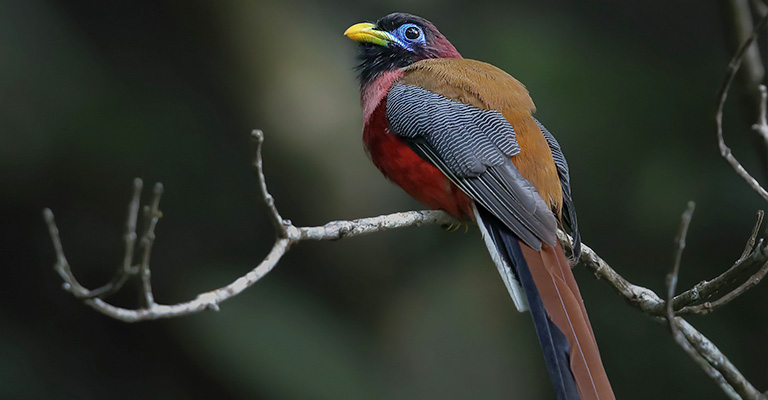
The Philippine trogon is a stunning bird, native to the Philippines. The male has a black head and throat, with blue on its face. Its neck and mantle are brown while its rump and tail are shades of red-brown.
The female’s colors are duller than her mate’s but still beautiful in their own right.
They inhabit subtropical or tropical moist lowland forests as well as montane forests up to 2200m elevation where they feed mainly on fruits such as figs along with insects that can be found among foliage or flying around them at dawn or dusk when they’re most active hunting for food.
These birds make their nests by drilling holes into trees which makes them unique compared to other Trogons who tend not to use this method for nesting.
Scientific classification:
| Kingdom | Animalia |
| Phylum | Chordata |
| Class | Aves |
| Order | Trogoniformes |
| Family | Trogonidae |
| Genus | Harpactes |
| Species | H. ardens |
Also Featured In: Birds of the Philippines,
2. Yellow-Breasted Fruit Dove
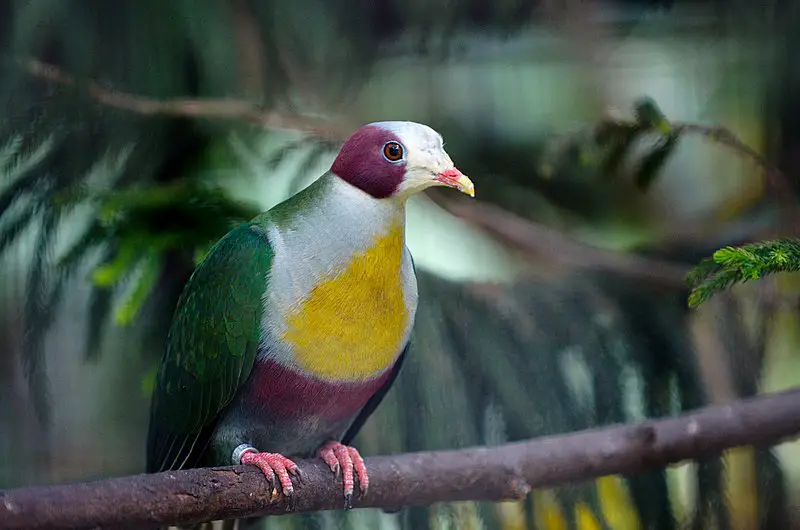
The Yellow-breasted fruit dove is a beautiful bird endemic to the Philippines. It lives in tropical moist lowland forests, however its population is declining due to habitat loss and illegal hunting or trapping for the wildlife trade.
This species has been listed as Least Concern by IUCN but conservation efforts are still needed if we want this species of bird survive.
The yellow-breasted fruit Dove has an overall yellowish colour with dark wings and tail feathers, red eyes and white spot on each side of their neck.
They feed mainly on fruits such as figs and berries which makes them important seed dispersers in their natural habitats while they also drink flower nectar like hummingbirds do.
Its illegal to hunt, capture or keep this lovely little creature so let’s all work together towards protecting it from extinction.
Scientific classification:
| Kingdom | Animalia |
| Phylum | Chordata |
| Class | Aves |
| Order | Columbiformes |
| Family | Columbidae |
| Genus | Ptilinopus |
| Species | P. occipitalis |
Also Featured In: Palawan Island Birds,
3. Bukidnon Woodcock
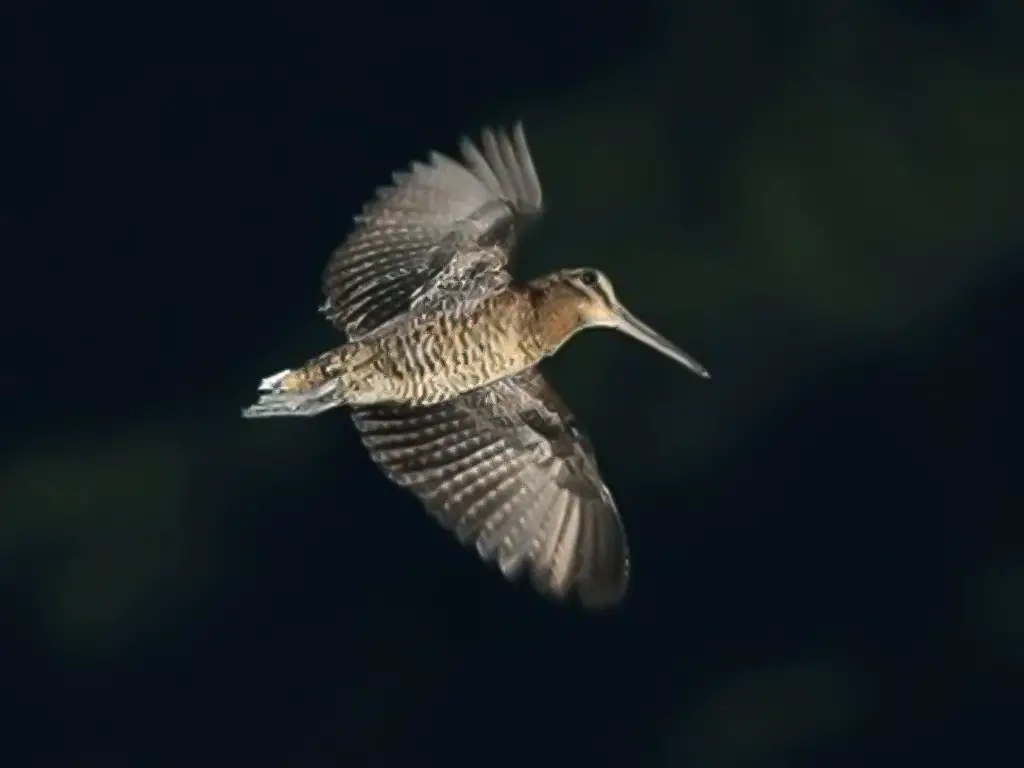
The Bukidnon woodcock is a medium-sized wader native to the Philippines. It was only described as new to science in 2001, although specimens were collected from Luzon Island decades earlier and misidentified as Eurasian woodcocks’ samples.
The bird wasn’t recognized until 1993 when it was heard calling for the first time, followed by more specimen collections on Mindanao island two years later.
Its plumage varies between males and females; while both have dark brown upperparts with lighter spots, male’s head has reddish hues whereas female ones are greyer.
This species feeds mainly on earthworms but also consumes insects and spiders during wetter months of the year.
Scientific classification:
| Kingdom | Animalia |
| Phylum | Chordata |
| Class | Aves |
| Order | Charadriiformes |
| Family | Scolopacidae |
| Genus | Scolopax |
| Species | S. bukidnonensis |
4. Apo Myna
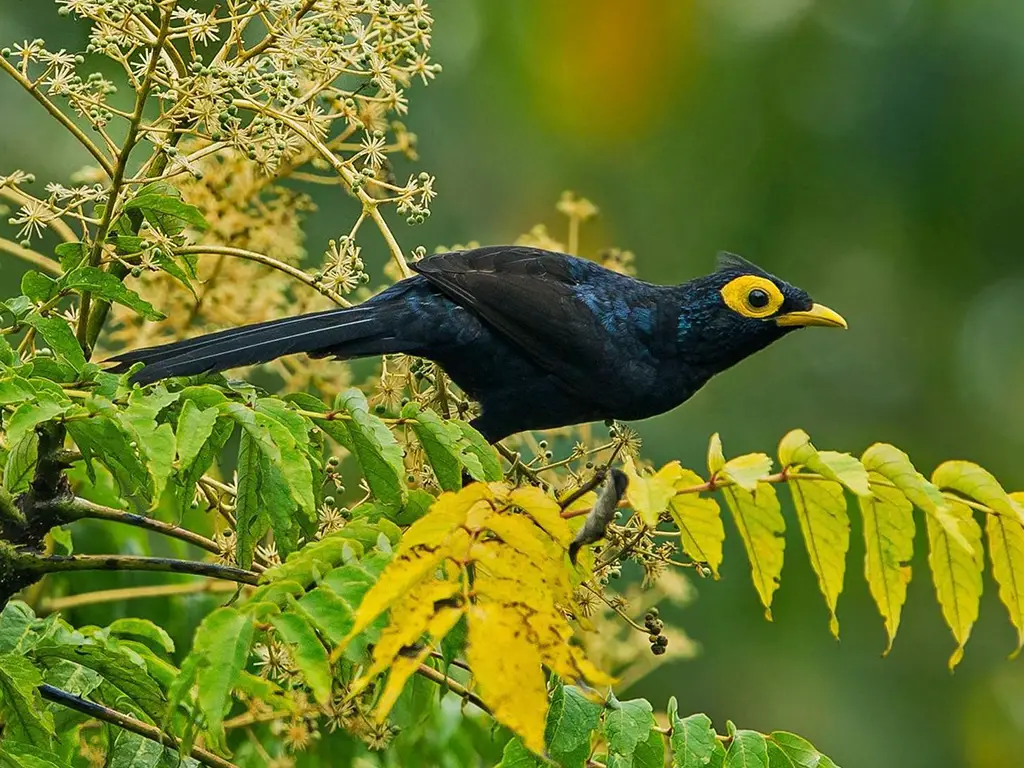
The Apo myna is a species of starling in the Sturnidae family, found only in Mindanao’s tropical montane forests.
It was previously classified under the genus Goodfellowia, which it is still known as today and also referred to as Mount Apo Starling or King Starling.
This bird has striking grey-black colouring with white spots on its wings and tail feathers. Its diet consists mainly of fruit supplemented by insects such as beetles, ants and grasshoppers.
Sadly, this species faces threat from deforestation due to expansion of agricultural land for crops like coffee beans which are grown commercially up in these areas; leading to loss of their natural habitat .
To save them from becoming extinct , conservation efforts should be made immediately so that future generations can continue admiring this beautiful creature.
Scientific classification:
| Kingdom | Animalia |
| Phylum | Chordata |
| Class | Aves |
| Order | Passeriformes |
| Family | Sturnidae |
| Genus | Goodfellowia Hartert, 1903 |
| Species | G. miranda |
5. Philippine Pygmy Woodpecker
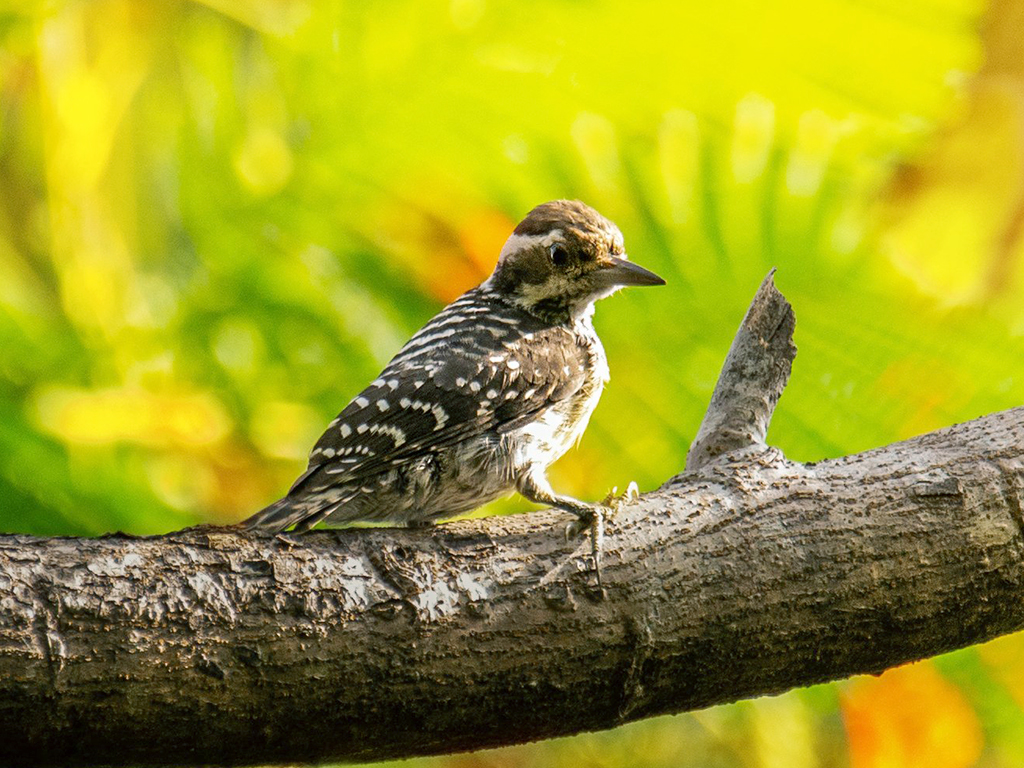
The Philippine pygmy woodpecker is a small species of bird in the Picidae family. It has three different subspecies, validirostris, maculatus and menagei.
These birds have blackish-brown feathers on their back that are moderately barred with white stripes, as well as a white throat which features a dark spot.
In Kapampangan they are called Anluage. They can be seen living in forests and woodlands mostly around the Philippines but also parts of Indonesia and Malaysia where there is suitable habitat for them to survive; such habitats include mangroves and coastal areas.
The Philippine pygmy woodpecker does not migrate due to its size so it remains within its area even during winter times when food sources become scarce or difficult to find because of snowfall or lack thereof.
Scientific classification:
| Kingdom | Animalia |
| Phylum | Chordata |
| Class | Aves |
| Order | Piciformes |
| Family | Picidae |
| Genus | Yungipicus |
| Species | Y. maculatus |
6. Philippine Hanging Parrot
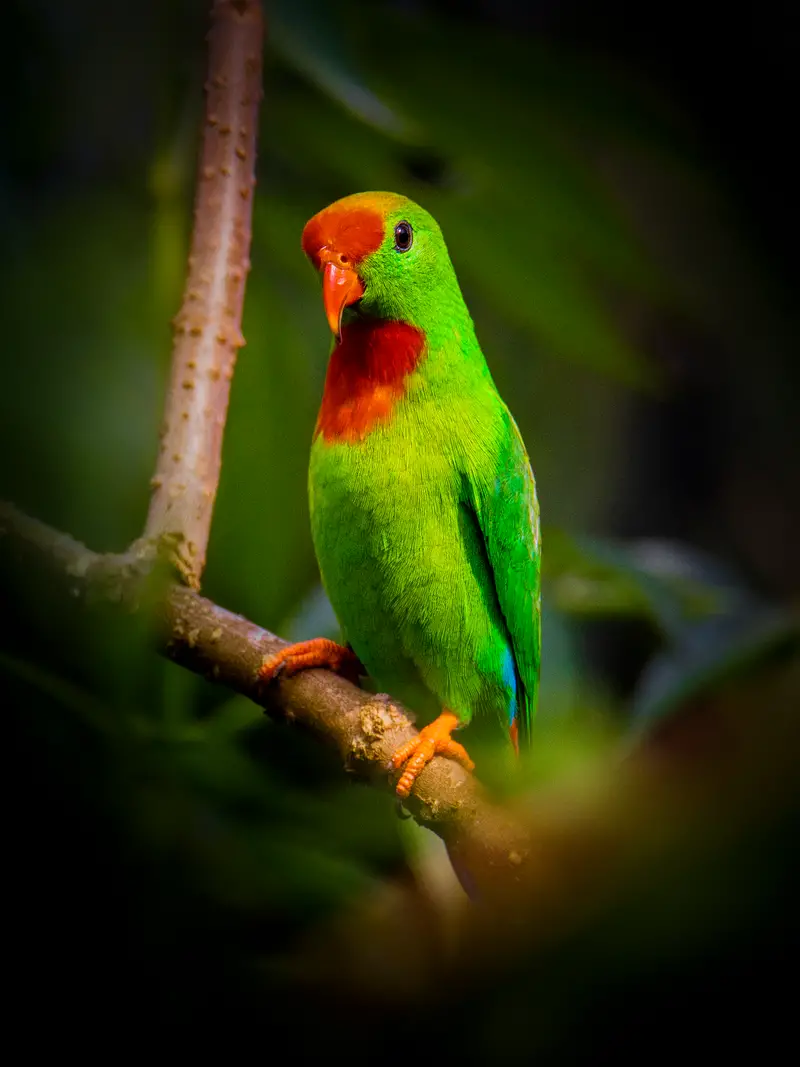
The Philippine Hanging Parrot is a small, psittaculid parrot species found in the Philippines. It has 11 subspecies, one of which may be distinct from the others.
The bird is known by its local Tagalog name ‘Kulasisi’. This beautiful bird can usually be seen hanging upside down on thin branches or vines and feeds mainly on fruits and flowers.
Despite being listed as Least Concern by IUCN, some of its subspecies are under threat due to deforestation and illegal trapping for pet trade.
Conservation efforts must therefore be taken to ensure their survival in the wild.
Scientific classification:
| Kingdom | Animalia |
| Phylum | Chordata |
| Class | Aves |
| Order | Psittaciformes |
| Family | Psittaculidae |
| Genus | Loriculus |
| Species | L. philippensis |
7. Southern Silvery Kingfisher
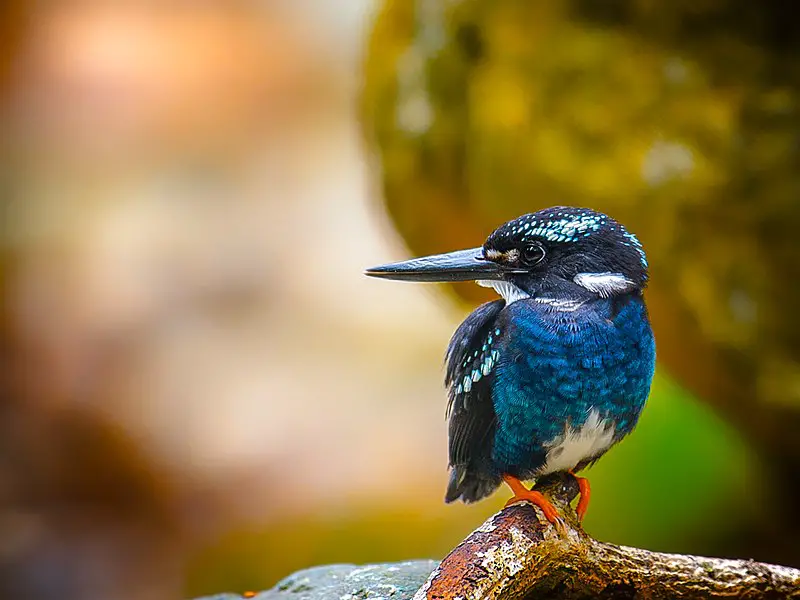
The Southern silvery kingfisher (Ceyx argentatus) is a species of bird that can only be found in the Philippines. It inhabits tropical moist lowland forests, streams and rivers located on Mindanao and Basilan Islands.
This stunning species was formerly considered to belong with the Northern silvery kingfisher from Visayas before being recognised as its own separate kind.
The beautiful blue-green colouring combined with white underparts make this tiny creature stand out among other birds of similar size.
Sadly, it is threatened due to habitat destruction which means conservation efforts are essential for its survival into the future.
Scientific classification:
| Kingdom | Animalia |
| Phylum | Chordata |
| Class | Aves |
| Order | Coraciiformes |
| Family | Alcedinidae |
| Subfamily | Alcedininae |
| Genus | Ceyx |
| Species | C. argentatus |
Also Featured In: Silver Birds You Should Know,
8. Azure-Breasted Pitta
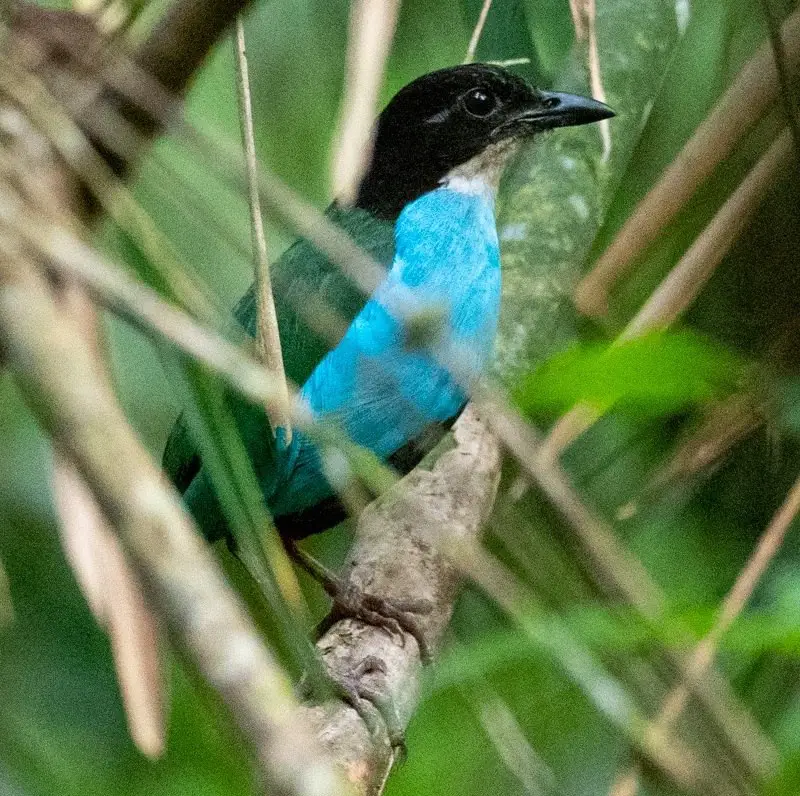
The Azure-breasted pitta is a strikingly beautiful bird found in the Philippines. It has stunning colors of azure, red, black and white.
The species is classified as endangered due to habitat loss and can only be seen within its natural environment of tropical moist lowland forests on Mindanao, Bohol, Leyte and Samar islands.
Measuring at medium size with an elongated body shape it forages for insects among leaves or on the ground occasionally taking short flights from tree to tree when disturbed.
Despite not being able to survive outside of protected areas this species still brings joy through its vibrant beauty which will hopefully remain around for many years more.
Scientific classification:
| Kingdom | Animalia |
| Phylum | Chordata |
| Class | Aves |
| Order | Passeriformes |
| Family | Pittidae |
| Genus | Pitta |
| Species | P. steerii |
9. Giant Scops Owl
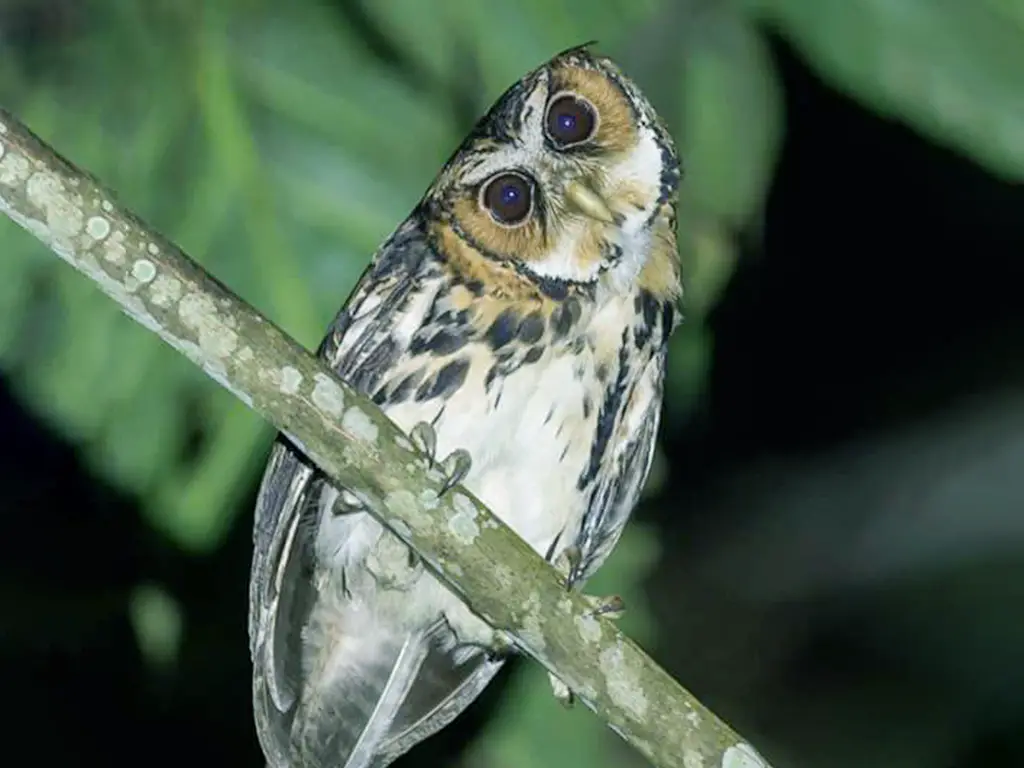
The Giant Scops Owl is an impressive bird native to the Philippines. Its size and structure make it stand out from other species of owls, being intermediate between a scops owl and an eagle-owl.
It usually inhabits tropical moist lowland forests but unfortunately, this habitat has been drastically reduced due to human activities leaving them at risk of extinction.
The Giant Scops Owl was first described as Pseudoptynx in 1887 by British ornithologist Alfred Henry Garrod and later reclassified into its current scientific name Otus gurneyi.
These birds have striking features like their tawny brown upperparts with white spots on their back feathers along with pale yellow eyes that makes them easy to spot when they’re hunting for prey during night time hours.
Scientific classification:
| Kingdom | Animalia |
| Phylum | Chordata |
| Class | Aves |
| Order | Strigiformes |
| Family | Strigidae |
| Genus | Otus |
| Species | O. gurneyi |
Also Featured In: Owls Species,
10. Elegant Tit
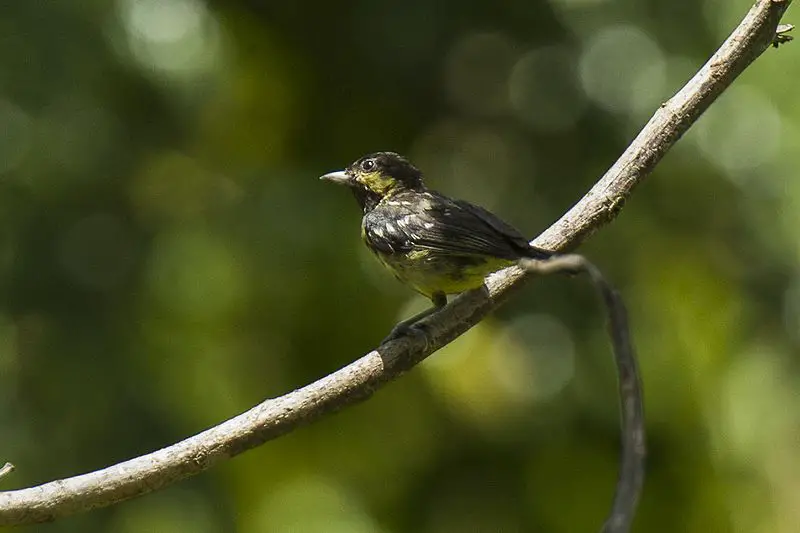
The Elegant tit bird is a beautiful species of tit that is found exclusively in the Philippines. Formerly classified under the Parus genus, it was subsequently reclassified under Pardaliparus along with the yellow-bellied tit and Palawan tit.
This change was based on the findings of a molecular study in 2013 that led to the resurrection of several genera.
The Elegant tit is known for its elegant features and is highly sought after by bird enthusiasts. This bird is a testament to the rich wildlife found in the Philippines and is a welcomed addition to the avian kingdom.
Overall, the Elegant tit bird is a unique and beautiful species that deserves admiration and protection.
Scientific classification:
| Kingdom | Animalia |
| Phylum | Chordata |
| Class | Aves |
| Order | Passeriformes |
| Family | Paridae |
| Genus | Pardaliparus |
| Species | P. elegans |
Also Featured In: Common Philippines Birds, Most Common Birds in Negros
11. Mindanao Bleeding-Heart
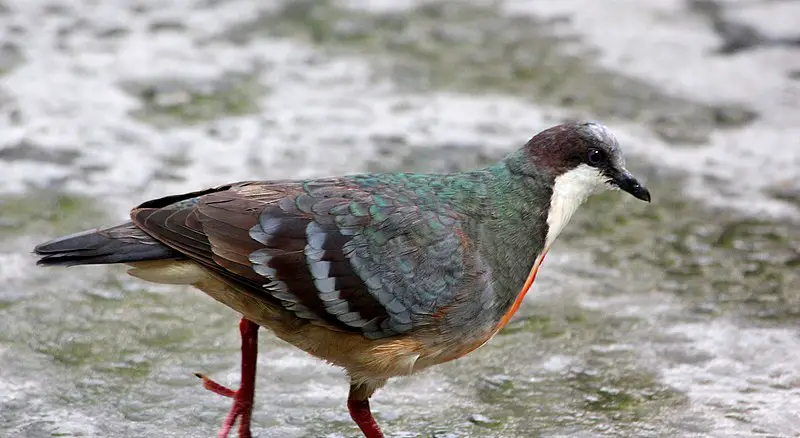
The Mindanao bleeding-heart bird is a pigeon species endemic to various Philippine islands, including Mindanao, Basilan, Samar, Leyte, and Bohol. Its distinguishing feature is a red blotch on its breast, which earned it its name.
This bird belongs to the pigeon family and is also known as Bartlett’s bleeding heart dove and the hair-breasted bleeding heart.
The generic name of the species reflects a fusion. The bird’s habitat and behavioral patterns are yet to be explored in greater detail.
The population of Mindanao bleeding-heart bird is threatened due to habitat loss and hunting. These birds are found in lowland forests, with most sightings occurring in primary and secondary forests.
There’s much to learn and discover about this species amidst the challenges they face in the wild.
Efforts are being made to protect and conserve their habitat and ensure their survival into the future.
Scientific classification:
| Kingdom | Animalia |
| Phylum | Chordata |
| Class | Aves |
| Order | Columbiformes |
| Family | Columbidae |
| Genus | Gallicolumba |
| Species | G. crinigera |
Also Featured In: Samar Island Birds You Should Know,
12. McGregor’s Cuckooshrike
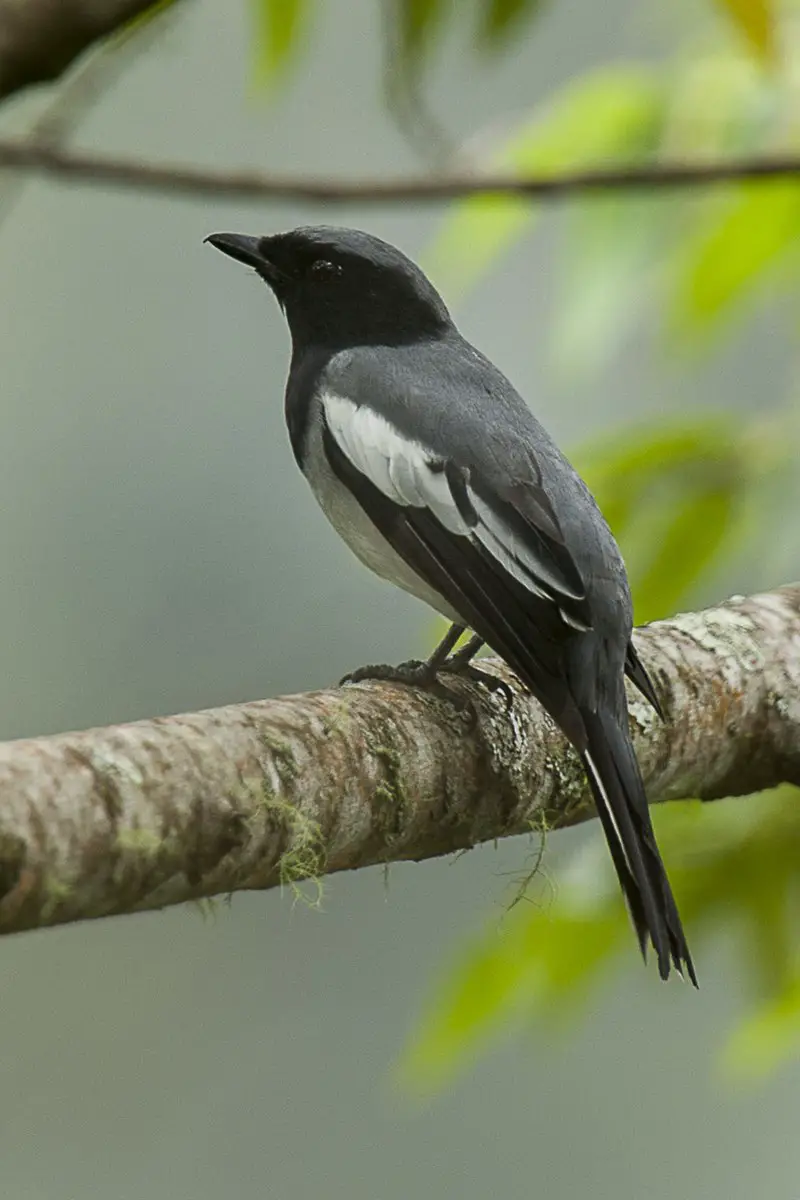
McGregor’s cuckooshrike, also known as the sharp-tailed cuckooshrike, is a unique bird species belonging to the Campephagidae family. This bird is exclusively found in the Mindanao island of the Philippines.
Initially, the species was categorized under the genus Coracina, but a 2010 molecular phylogenetic study deemed the genus non-monophyletic.
Consequently, a reorganization was necessary to create monophyletic genera, resulting in the introduction of Malindangia mcgregori.
McGregor’s cuckooshrike has distinct physical features such as a sharp tail, making it easy to differentiate from other bird species.
Scientific classification:
| Kingdom | Animalia |
| Phylum | Chordata |
| Class | Aves |
| Order | Passeriformes |
| Family | Campephagidae |
| Genus | Malindangia Mearns, 1907 |
| Species | M. mcgregori |
13. Pink-Bellied Imperial Pigeon
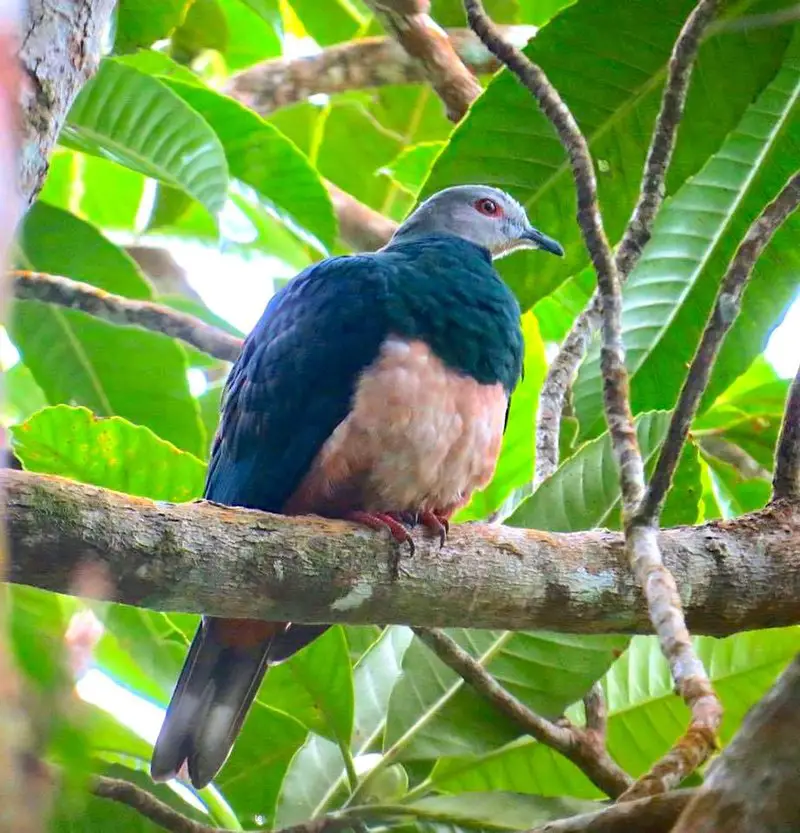
The Pink-bellied imperial pigeon, also called the zone-tailed pigeon, is a large bird found in the Philippines that can grow up to 42cm long. They are mostly dark green in color, with a gray head and a pink belly.
Their tail has a brown, black, and gray pattern, and their eyes and eye ceres are both red. The Pink-bellied imperial pigeon has a diet consisting mostly of fruit.
These birds are known for their stunning appearance and large size, making them an impressive sight in the wild.
They are a unique addition to the bird species of the Philippines, and their distinctive features make them stand out amongst other birds in the area.
Despite their size, Pink-bellied imperial pigeons are peaceful birds and pose no threat to humans or other animals.
Scientific classification:
| Kingdom | Animalia |
| Phylum | Chordata |
| Class | Aves |
| Order | Columbiformes |
| Family | Columbidae |
| Genus | Ducula |
| Species | D. poliocephala |
Also Featured In: Mindoro Birds You Should Know,
14. Philippine Spine-Tailed Swift
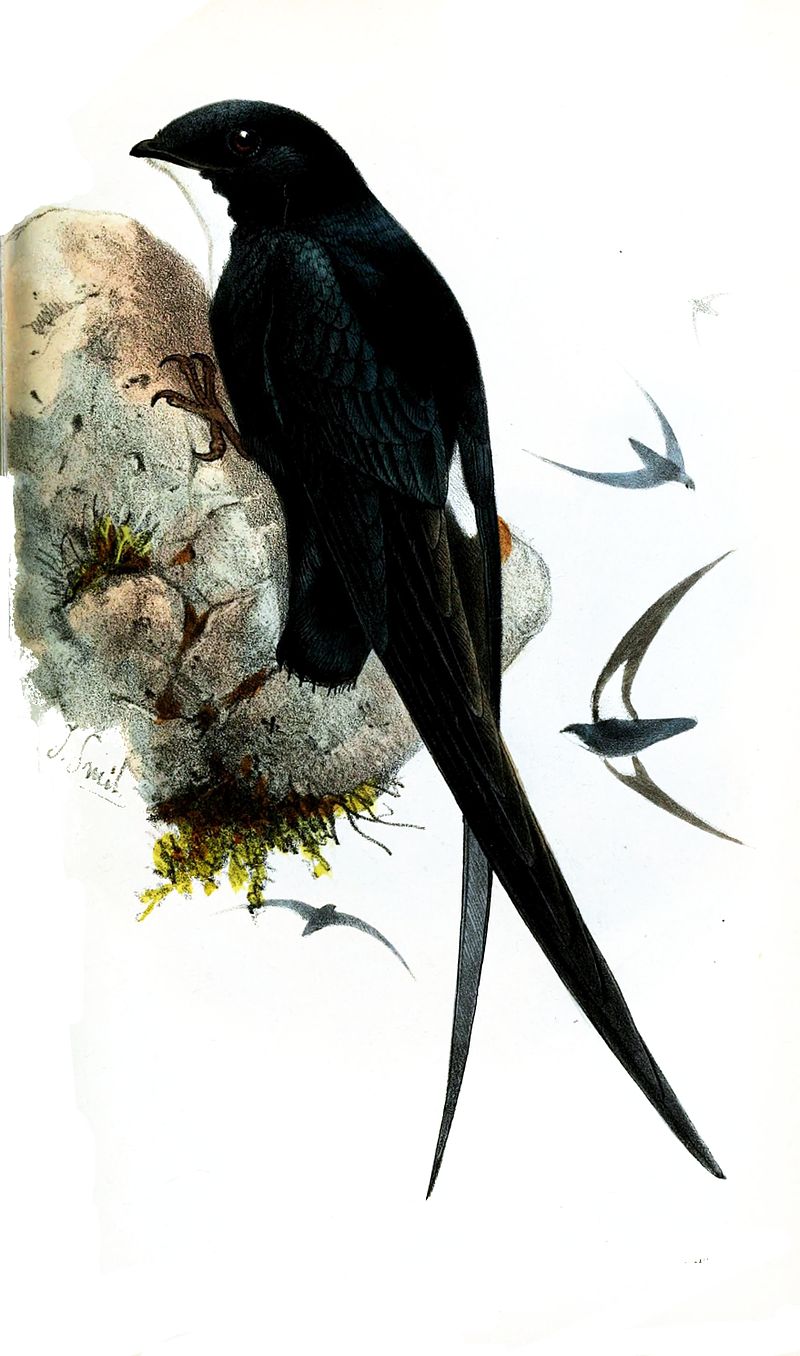
The Philippine spine-tailed swift is a swift species found only in the Philippines. This bird is known by several names, including the Philippine needletail and the Philippine spinetail.
It is a medium-sized bird that prefers to live in tropical moist lowland forests. Sadly, the species is slowly disappearing due to habitat loss.
Not much is known about this elusive bird, but it is important to preserve its natural habitat to ensure its survival.
Scientific classification:
| Kingdom | Animalia |
| Phylum | Chordata |
| Class | Aves |
| Clade | Strisores |
| Order | Apodiformes |
| Family | Apodidae |
| Genus | Mearnsia |
| Species | M. picina |
15. Philippine Coucal
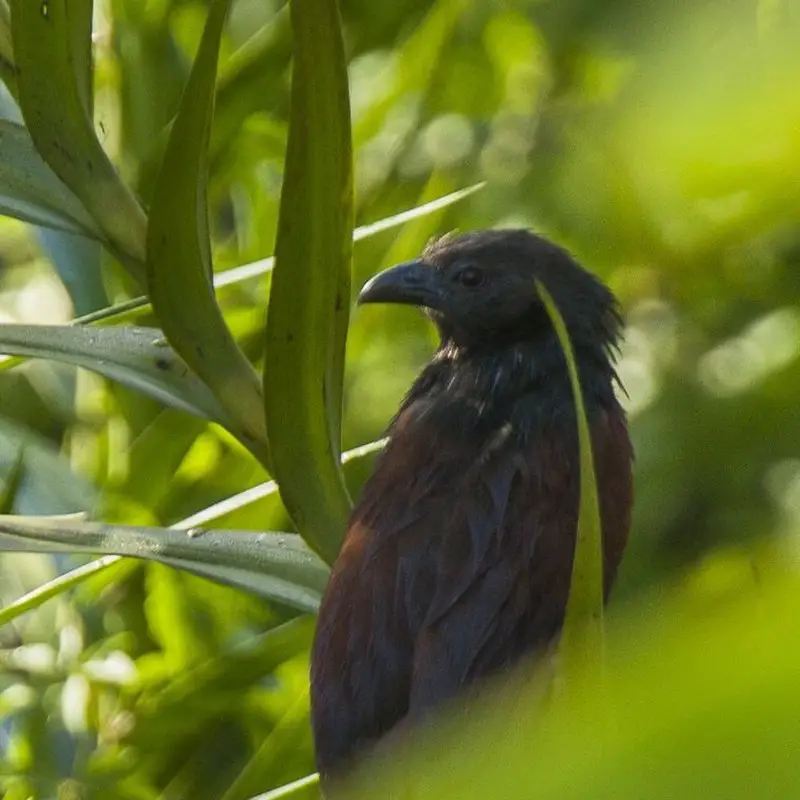
The Philippine coucal bird is a type of cuckoo found exclusively in the Philippines. This medium-sized bird has similar physical characteristics for both males and females, while different races of this species vary in color and size.
Some races, such as the carpenteri and mindorensis, appear completely black, while others like the viridis and majer display a black body with chestnut-colored wings. The carpenteri and majer variants are larger than viridis and mindorensis.
The viridis type possesses an overall black appearance, accented with a green sheen. As an endemic species, the Philippine coucal is only found in the Philippines, making it an important part of the country’s biodiversity.
Despite being a relatively lesser-known species compared to other birds, the Philippine coucal proves to be an interesting representative of avian life in the country.
Scientific classification:
| Kingdom | Animalia |
| Phylum | Chordata |
| Class | Aves |
| Order | Cuculiformes |
| Family | Cuculidae |
| Genus | Centropus |
| Species | C. viridis |
Also Featured In: Most Common Catanduanes Birds,
16. Yellowish Bulbul
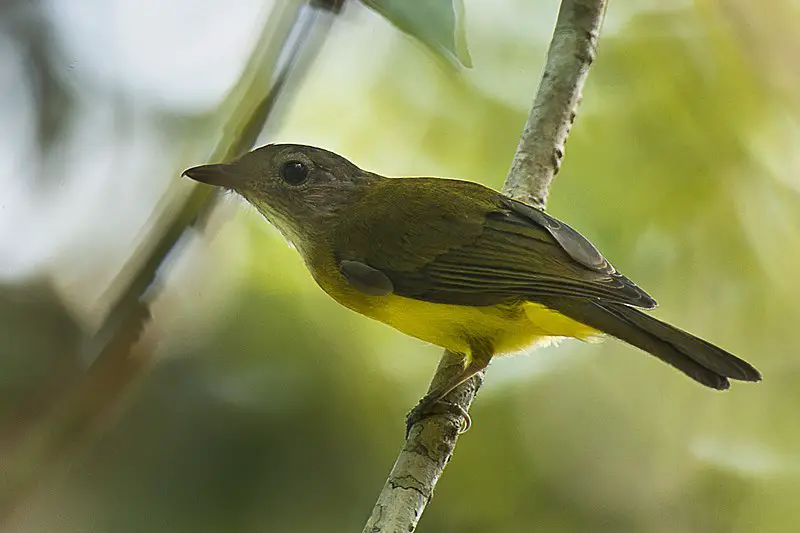
The Yellowish bulbul is a bird belonging to the bulbul family, Pycnonotidae. It was originally classified as Criniger, then Ixos and later re-classified as Hypsipetes in 2010.
Also known as Everett’s bulbul, plain-throated bulbul, and yellow-washed bulbul, this species has a yellowish coloration and is known for its melodious song. The bird is primarily found in Southeast Asia and is commonly found in forests and wooded areas.
The Yellowish bulbul is an active and agile bird that feeds on insects, berries and fruits. With its distinctive call and bright plumage, this bird is a popular sight among bird enthusiasts and nature lovers.
Scientific classification:
| Kingdom | Animalia |
| Phylum | Chordata |
| Class | Aves |
| Order | Passeriformes |
| Family | Pycnonotidae |
| Genus | Hypsipetes |
| Species | H. everetti |
Also Featured In: Siargao Island Birds You Didn’t Know,
17. Rufous Paradise Flycatcher
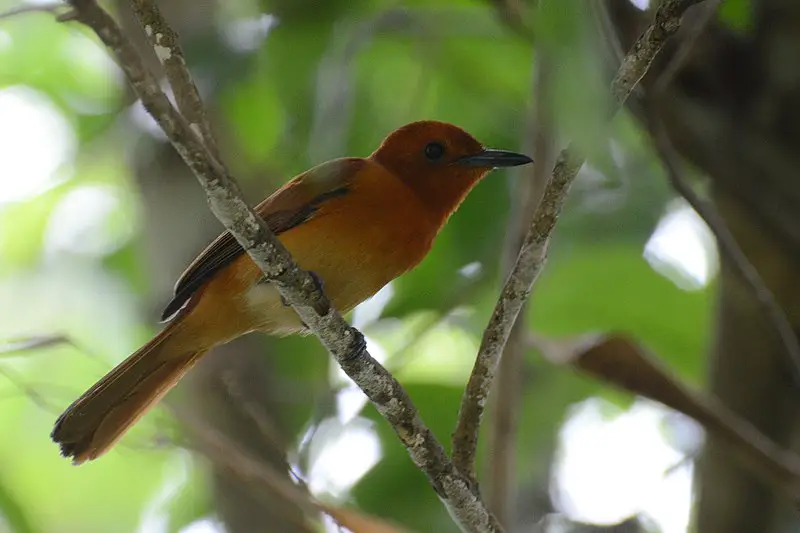
The Rufous Paradise Flycatcher, also known as the Cinnamon Paradise Flycatcher, is a bird that belongs to the family Monarchidae.
This species can be found in both Indonesia and the Philippines, living in subtropical or tropical moist lowland forests.
The bird has a distinct rufous coloring along with black and white plumes. The male and female look similar, but the female has a duller plumage.
It is a migratory bird that spends the breeding season in Indonesia and the non-breeding season in the Philippines.
The Rufous Paradise Flycatcher is known for feeding on insects and occasionally fruits. This bird has three recognized subspecies. Despite being of least concern, it is threatened by habitat loss due to deforestation.
Scientific classification:
| Kingdom | Animalia |
| Phylum | Chordata |
| Class | Aves |
| Order | Passeriformes |
| Family | Monarchidae |
| Genus | Terpsiphone |
| Species | T. cinnamomea |
18. Winchell’s Kingfisher
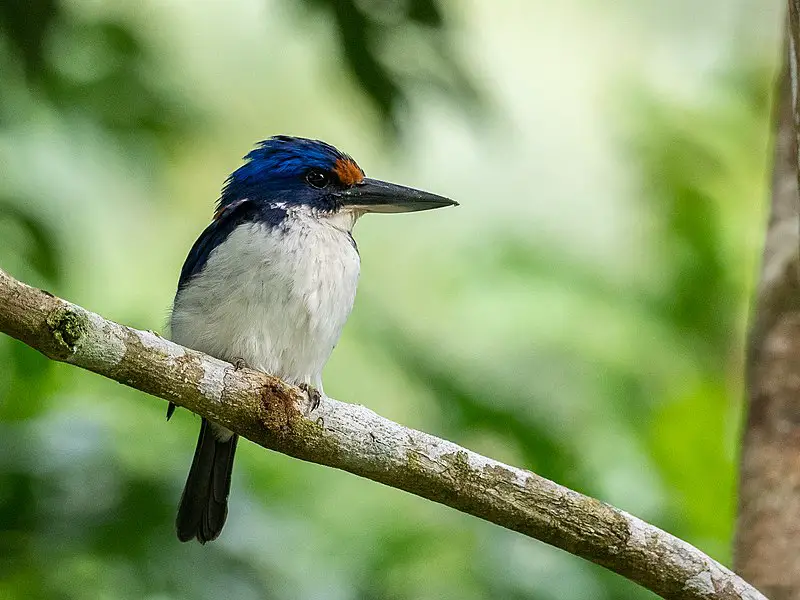
The Winchell’s kingfisher, also known as the rufous-lored kingfisher, is a bird belonging to the family Alcedinidae. Native to the Philippines, it typically inhabits lowland forests.
This species is vulnerable due to deforestation, making it a concern for the International Union for Conservation of Nature. Initially classified as Halcyon, the Winchell’s kingfisher is threatened in its natural habitat.
It has a distinctive rufous-colored crest and orange underparts, giving it a stunning appearance. While it can often be spotted perched in trees, it is difficult to find due to its declining population.
The Winchell’s kingfisher is a reminder that conservation efforts are important in preserving the diversity of avian species.
Scientific classification:
| Kingdom | Animalia |
| Phylum | Chordata |
| Class | Aves |
| Order | Coraciiformes |
| Family | Alcedinidae |
| Subfamily | Halcyoninae |
| Genus | Todiramphus |
| Species | T. winchelli |
19. Striated Wren-Babbler
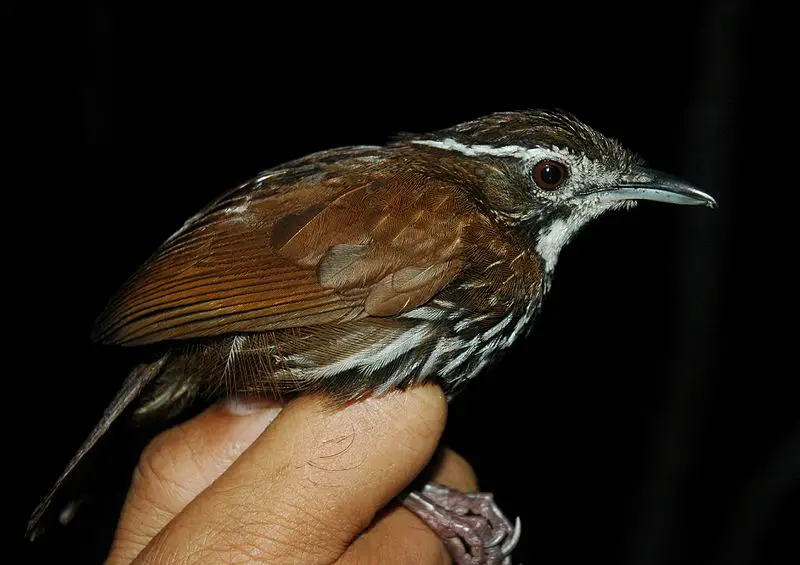
The Striated wren-babbler is a type of bird found only in the Philippines. It belongs to the Pellorneidae family, which is made up of passerine birds.
These birds generally live in subtropical or tropical forests that are moist, whether they are on a lowland or a montane.
Their scientific name is Ptilocichla mindanensis. The Striated wren-babbler is a distinctive bird, with stripes on various parts of its body.
Despite its name, it is not actually a wren, but its small, energetic movements could lead one to make that assumption.
Overall, the Striated wren-babbler is a unique and fascinating bird that is a significant part of the wildlife in the Philippines.
Scientific classification:
| Kingdom | Animalia |
| Phylum | Chordata |
| Class | Aves |
| Order | Passeriformes |
| Family | Pellorneidae |
| Genus | Ptilocichla |
| Species | P. mindanensis |
20. Black-Faced Coucal
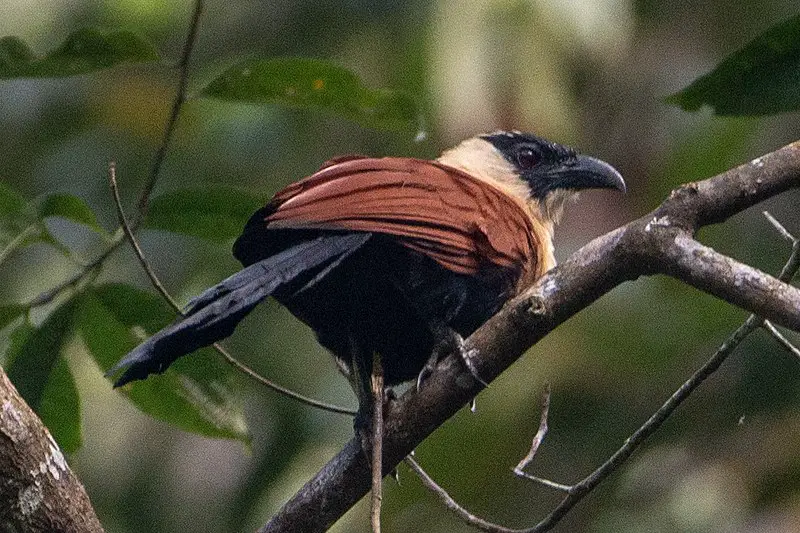
Known as a species of cuckoo, the black-faced coucal bird is found solely in the Philippines. It thrives in subtropical and tropical moist lowland forests, making it a rare sight to see.
Unlike most cuckoos which have distinct markings, the black-faced coucal is predominantly black. With its unique appearance, it may be easily recognized even from afar.
Although its nesting habits have yet to be fully documented, it is assumed that they lay eggs in the nests of other bird species.
These birds prefer to stay hidden within the undergrowth, making it more difficult to spot them. However, their distinct calls can be heard in their habitat.
Overall, the black-faced coucal is a fascinating bird that contributes to the biodiversity of the Philippines.
Scientific classification:
| Kingdom | Animalia |
| Phylum | Chordata |
| Class | Aves |
| Order | Cuculiformes |
| Family | Cuculidae |
| Genus | Centropus |
| Species | C. melanops |
21. Philippine Fairy-Bluebird
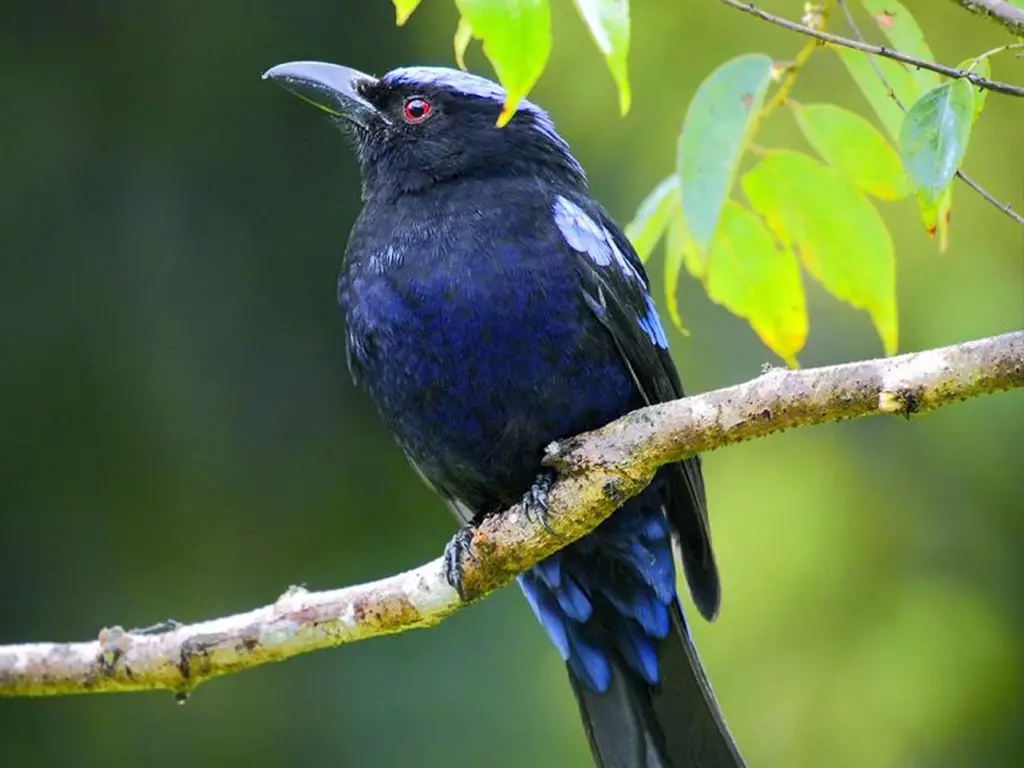
The Philippine fairy-bluebird is a bird species found only in the Philippines, particularly in the islands of Luzon, Mindanao, Samar, and Bohol. This bird is known for its vibrant blue feathers, which can be seen on its wings and tail.
It can be found in the tropical moist lowland forest and tropical moist montane forest regions. Often, they can be seen moving around in mixed flocks along with other forest birds such as Philippine bulbuls and Blue-headed fantails.
The Philippine fairy-bluebird is a threatened species, with their habitat being destroyed due to deforestation, agriculture, and human encroachment.
Conservation efforts are being done to protect this beautiful bird species and its home.
Scientific classification:
| Kingdom | Animalia |
| Phylum | Chordata |
| Class | Aves |
| Order | Passeriformes |
| Family | Irenidae |
| Genus | Irena |
| Species | I. cyanogastra |
22. Zamboanga Bulbul
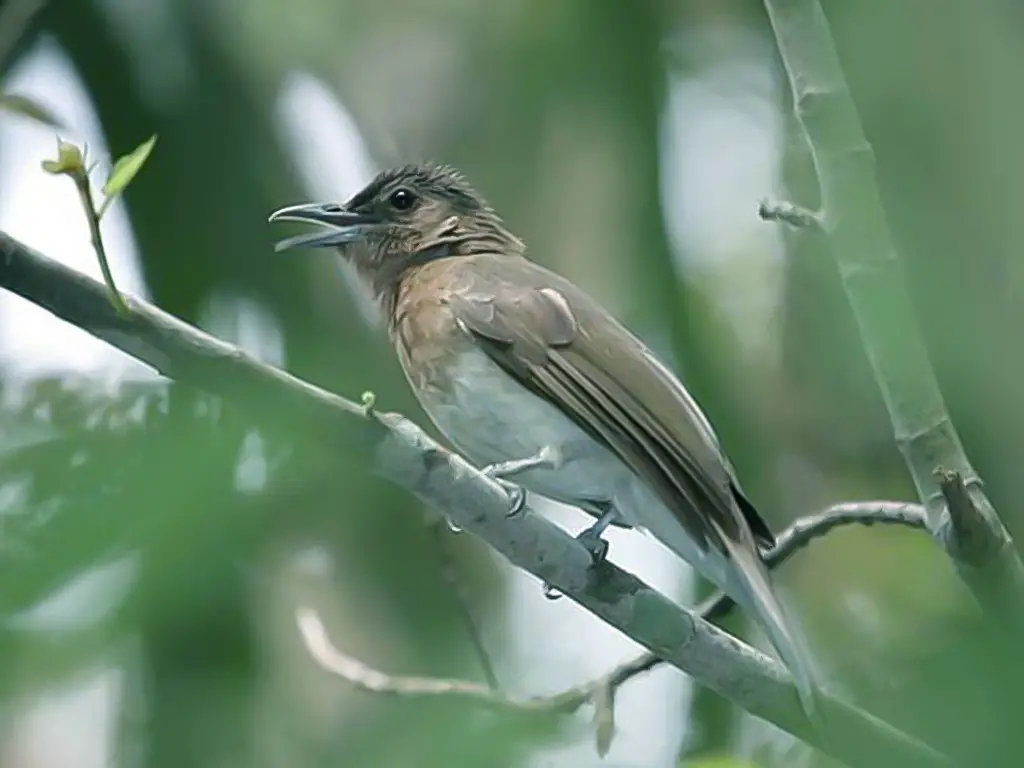
The Zamboanga bulbul is a beautiful and rare songbird species that belongs to the bulbul family. It is endemic to the Philippines and can be found in the subtropical or tropical moist lowland forests of Basilan and the Zamboanga Peninsula.
Unfortunately, the species is becoming increasingly rare due to habitat loss. The Zamboanga bulbul was first described in the genus Hypsipetes and was later placed in the genus Ix.
The bird’s striking appearance and unique songs make it a valuable addition to the ecosystem.
It is important to protect the Zamboanga bulbul’s natural habitat to ensure its survival for generations to come.
Scientific classification:
| Kingdom | Animalia |
| Phylum | Chordata |
| Class | Aves |
| Order | Passeriformes |
| Family | Pycnonotidae |
| Genus | Hypsipetes |
| Species | H. rufigularis |
23. Apo Sunbird
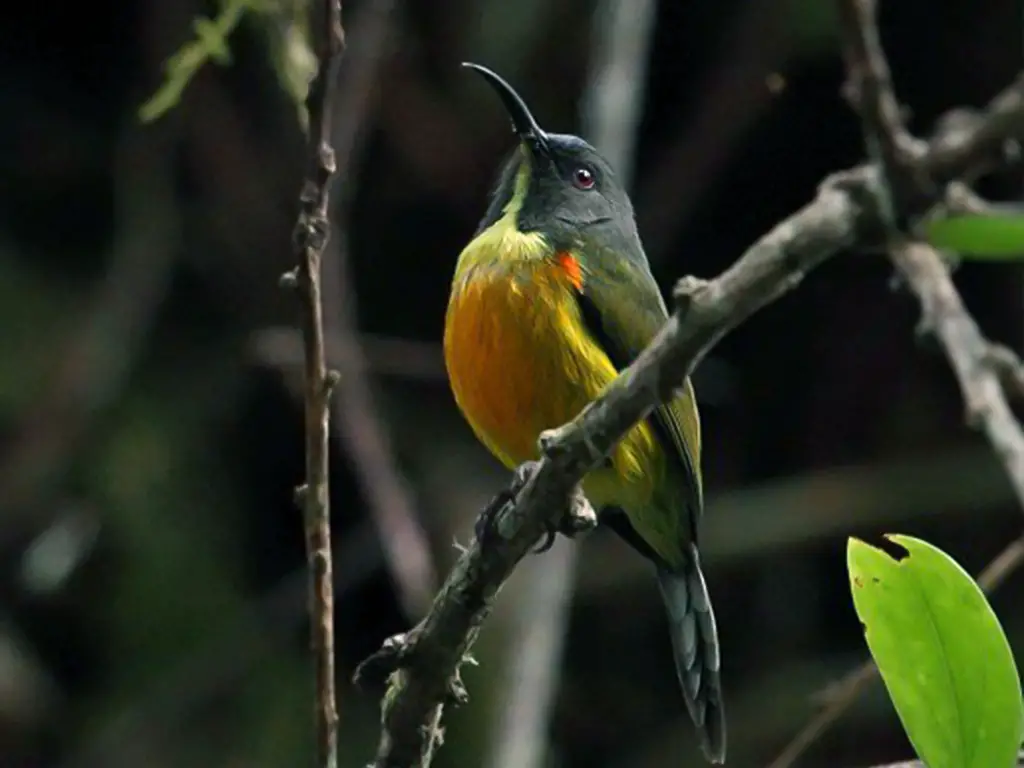
The Apo sunbird is a species of bird unique to the island of Mindanao in the Philippines. This small but beautiful bird belongs to the sunbird family Nectariniidae.
Male and female Apo sunbirds have distinct differences in appearance despite their shared characteristics. Both have an olive-colored back and wings, white-tipped tails, and a yellow underbelly.
However, the male has a vibrant, metallic green head and throat, while the female has a duller olive-green head and grey throat. Another defining feature is their long, curved bill, which they use to feed on nectar from flowers.
The Apo sunbird is an important part of the island’s ecosystem and is also a popular bird for birdwatchers to spot and admire.
Scientific classification:
| Kingdom | Animalia |
| Phylum | Chordata |
| Class | Aves |
| Order | Passeriformes |
| Family | Nectariniidae |
| Genus | Aethopyga |
| Species | A. boltoni |
24. Olive-Capped Flowerpecker
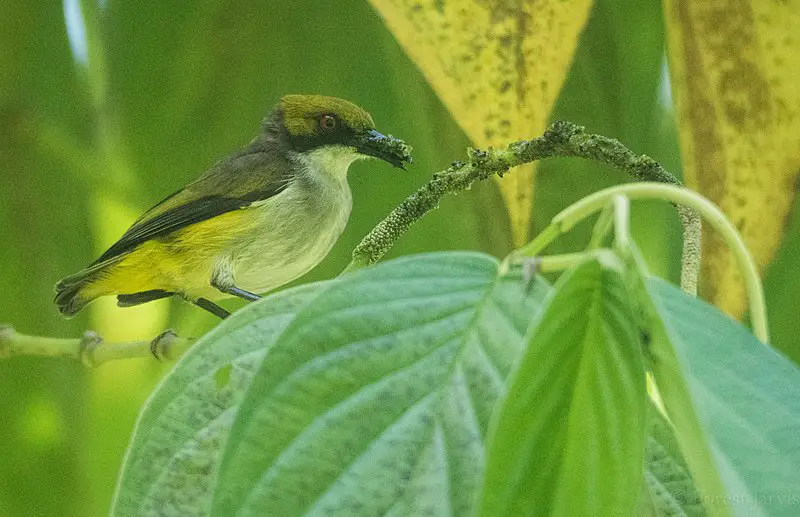
The Olive-capped flowerpecker is a small bird found only in the Philippines on the island of Mindanao. Its natural habitat is in tropical moist montane forests.
This bird has an olive-green back and a darker edge on its wings. Its head is a unique golden-olive color, and it has a pale gray throat. The bird’s distinctive long bill helps it feed on the nectar of flowers.
It is part of the Dicaeidae family and is categorized as an endemic species, meaning it is only found in a specific geographic location. Despite its small size, the Olive-capped flowerpecker plays an important role in pollinating flowers in its natural habitat.
Scientific classification:
| Kingdom | Animalia |
| Phylum | Chordata |
| Class | Aves |
| Order | Passeriformes |
| Family | Dicaeidae |
| Genus | Dicaeum |
| Species | D. nigrilore |
25. Grey-Hooded Sunbird

The Grey-hooded sunbird is a stunning bird that is found only in the Philippines. It is a small bird that is typically found in tropical moist montane forests.
This bird has a grey hood and chest, with an olive-green back and wings. Its upper belly is white, while its lower belly and sides are yellow. A unique feature of the Grey-hooded sunbird is its white tail-tip.
It is a beautiful sight to see this bird flitting among the trees in its natural habitat. It is a nectarivorous bird, feeding on the sweet nectar of flowers.
The Grey-hooded sunbird is a reminder of the unique birdlife that can be found in the Philippines and the importance of protecting these delicate ecosystems.
Scientific classification:
| Kingdom | Animalia |
| Phylum | Chordata |
| Class | Aves |
| Order | Passeriformes |
| Family | Nectariniidae |
| Genus | Aethopyga |
| Species | A. primigenia |
26. Black-Headed Tailorbird
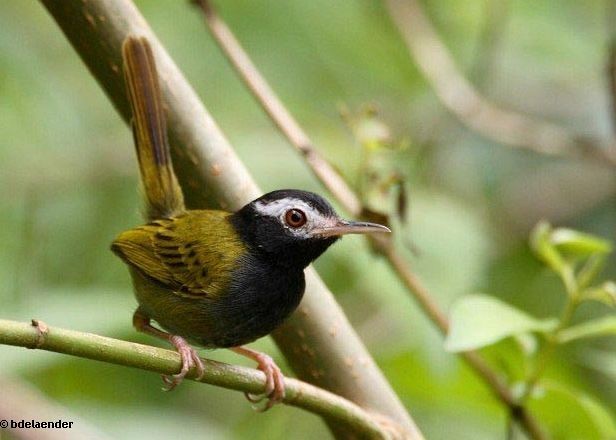
The Black-headed tailorbird is a small songbird found in the southeastern Philippine islands of Mindanao, Dinagat and Siargao. This species was previously grouped with the “Old World warbler” family.
Adult plumage is sexually monomorphic, meaning males and females appear similar. This bird has a black head, hence its name, and distinct white spots on its wings.
The ventral plumage of specimens from Dinagat and Siargao is brighter and yellower than those found on Mindanao.
As its name suggests, the Black-headed tailorbird is an expert tailor, using plant materials to sew its nests. The species is presently considered of least concern by the International Union for Conservation of Nature.
Overall, the Black-headed tailorbird is an interesting and unique bird species native to the beautiful islands of the eastern Philippines.
Scientific classification:
| Kingdom | Animalia |
| Phylum | Chordata |
| Class | Aves |
| Order | Passeriformes |
| Family | Cisticolidae |
| Genus | Orthotomus |
| Species | O. nigriceps |
27. White-Eared Tailorbird
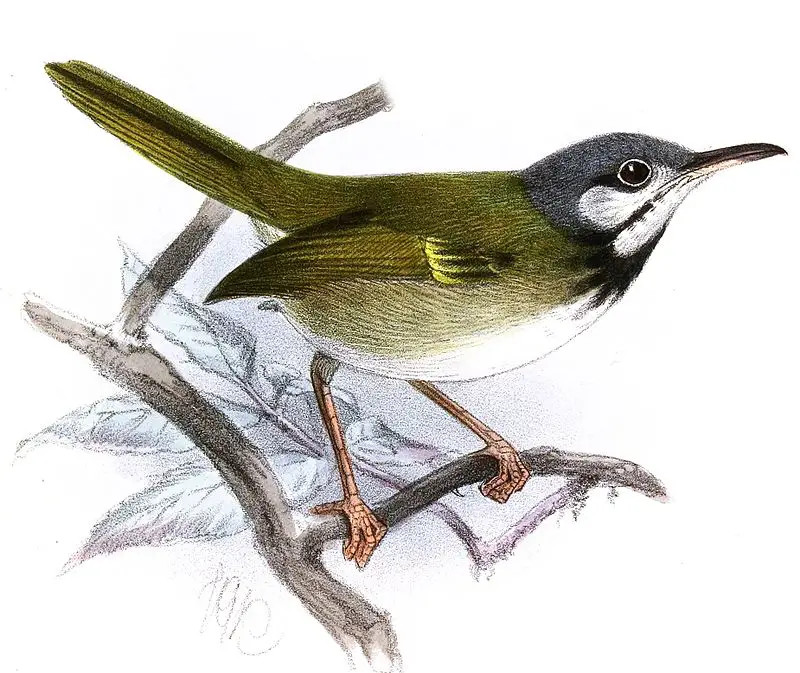
The white-eared tailorbird is a small bird with a long bill and tail. Found in the dense undergrowth of lowland and foothill forests in Basilan and West Mindanao, this bird’s coloration is primarily olive.
This species was once a part of the “Old World warbler” group but has since been categorized into the family Cisticolidae. Despite its small size, it is notable for its distinct white ear patch that sets it apart from other tailorbirds.
This bird is a rare sight to observe due to its preference for dense habitats, and its small size can make it challenging to spot. However, it is well worth the effort to catch a glimpse of this unique and striking species.
Scientific classification:
| Kingdom | Animalia |
| Phylum | Chordata |
| Class | Aves |
| Order | Passeriformes |
| Family | Cisticolidae |
| Genus | Orthotomus |
| Species | O. cinereiceps |
28. Little Slaty Flycatcher
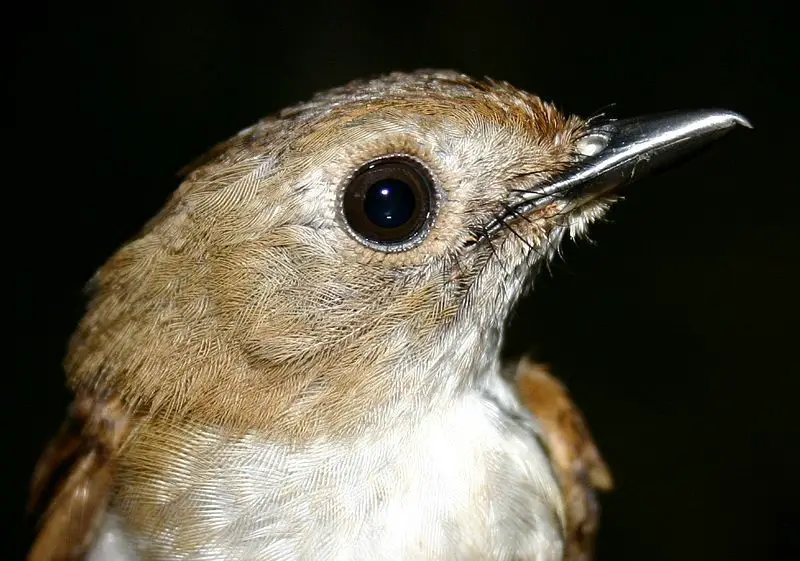
The Little slaty flycatcher is a bird found in the tropical lowland forests of Mindanao, Leyte, and Samar in the Philippines. This small bird prefers to live amidst the tangled undergrowth in the forest and is threatened by loss of its natural habitat.
With its notable pale orange legs and white underside, the Little slaty flycatcher is a charming sight to behold. As a member of the Muscicapidae family, it is known for its ability to catch insects on the wing.
The Little slaty flycatcher’s existence represents an important part of the biodiversity found in the Philippines and highlights the importance of conservation efforts to preserve the natural habitat of this wonderful bird.
Scientific classification:
| Kingdom | Animalia |
| Phylum | Chordata |
| Class | Aves |
| Order | Passeriformes |
| Family | Muscicapidae |
| Genus | Ficedula |
| Species | F. basilanica |
29. Slaty-Backed Jungle Flycatcher
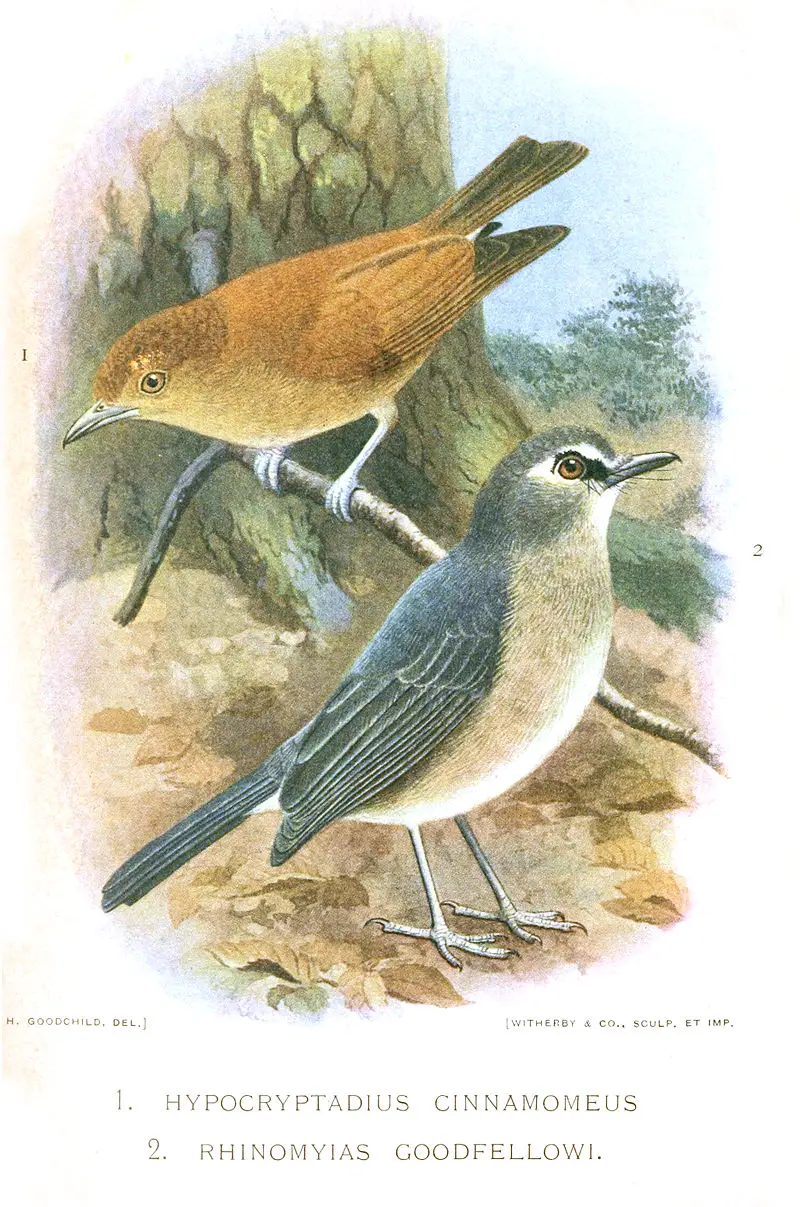
The Slaty-backed jungle flycatcher is a bird species endemic to the Philippines. It belongs to the Old World flycatcher family Muscicapidae and thrives in subtropical or tropical moist montane forests.
This bird is becoming rare due to habitat destruction. The specific epithet of the species name, goodfellowi, honours the British zoological collector, Walter Goodfellow.
Scientific classification:
| Kingdom | Animalia |
| Phylum | Chordata |
| Class | Aves |
| Order | Passeriformes |
| Family | Muscicapidae |
| Genus | Vauriella |
| Species | V. goodfellowi |
30. Cryptic Flycatcher
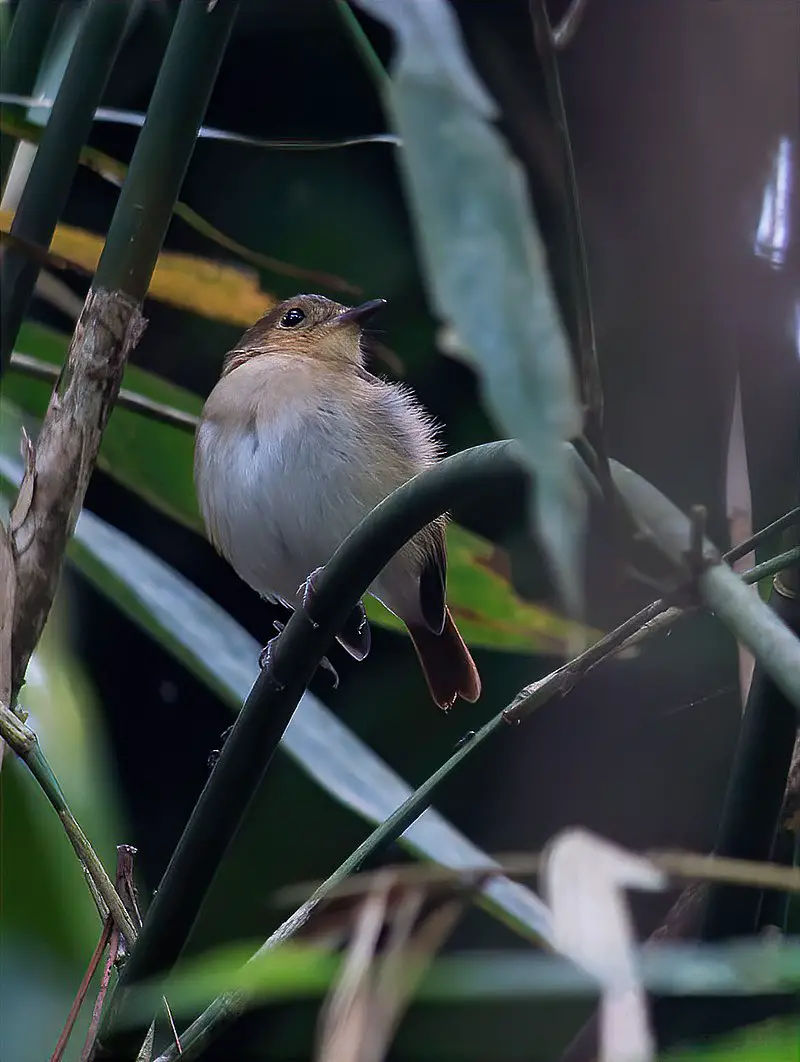
The Cryptic flycatcher is a small bird found only in the Philippines on the island of Mindanao. It resides in tropical moist mid-montane forests at altitudes ranging from 600 to 1,500 meters.
This bird belongs to the family Muscicapidae and has a dark brown upper body, rufous tail, white belly, pale grey chest, and buffy face and throat. Its specific name, crypta, means ‘hidden’ in Latin, which is fitting as it is predominantly elusive and difficult to spot.
This unique species is exclusive to the Philippines and plays a crucial role in maintaining ecological balance in its natural habitat.
Scientific classification:
| Kingdom | Animalia |
| Phylum | Chordata |
| Class | Aves |
| Order | Passeriformes |
| Family | Muscicapidae |
| Genus | Ficedula |
| Species | F. crypta |
31. Red-Eared Parrotfinch
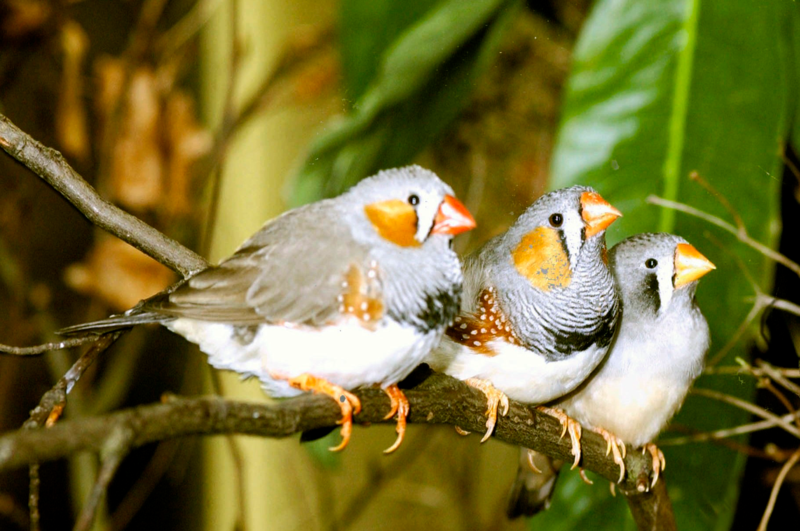
The red-eared parrotfinch is a striking species of estriildid finch found only on the island of Mindanao in the Philippines. It prefers to inhabit forest understorey, second growth, and grassy clearings at high altitudes above 1,000 meters.
Despite its exclusive range and habitat preferences, the IUCN currently lists the red-eared parrotfinch as a species of Least Concern. This bird can be found on virtually every mountain in central Mindanao.
Despite being quite common, the red-eared parrotfinch is a very elusive species that tends to stay out of sight and remain hidden in the foliage.
Its vibrant colors and unique features, such as its bright red ears, make it an intriguing sight for bird watchers lucky enough to catch a glimpse of this elusive species.
Scientific classification:
| Kingdom | Animalia |
| Phylum | Chordata |
| Class | Aves |
| Order | Passeriformes |
| Family | Estrildidae |
| Genus | Erythrura |
| Species | E. coloria |
32. Hombron’s Kingfisher
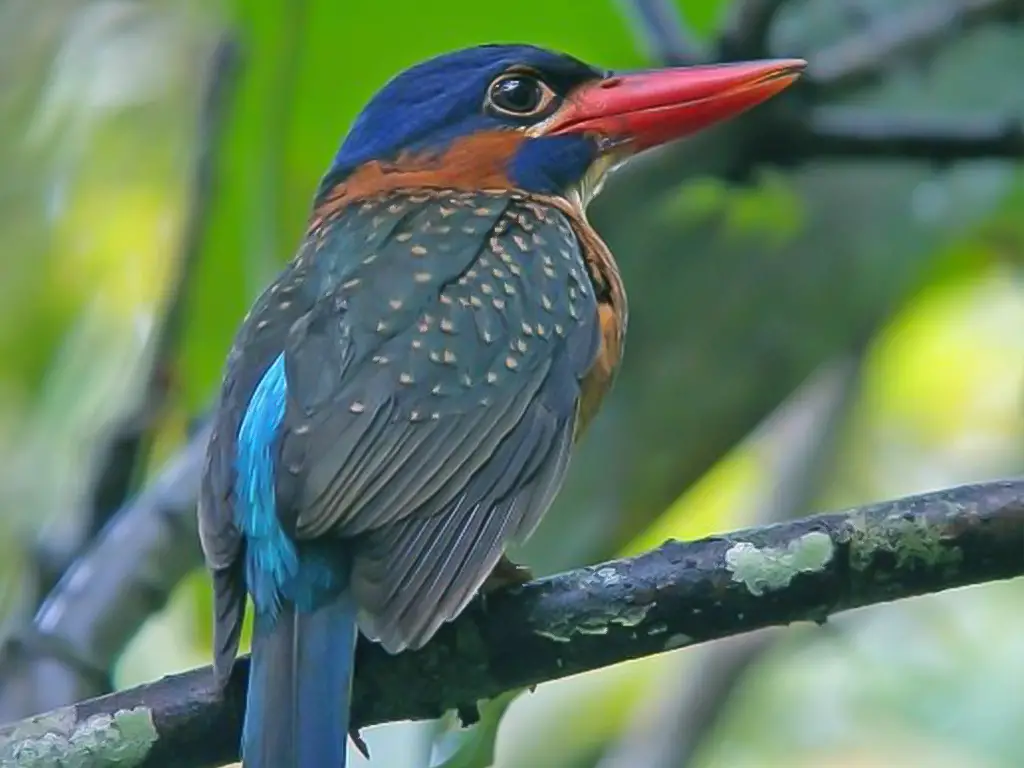
The Hombron’s kingfisher, also known as the blue-capped kingfisher, is a brightly colored bird species found exclusively in the Philippines, on the island of Mindanao.
With its striking dark blue (green for females) cap and wings with rufous spots, this bird is one of the most colorful kingfishers in the country. Its white chin and red bill add to its striking appearance.
This species is found in the upper ranges of the island, and is typically seen in forested habitats. The Hombron’s kingfisher is a member of the Alcedinidae family and is known for its distinctive rufous belly.
This species is endemic to the Philippines, which means that it is found nowhere else in the world. Despite its beautiful appearance, the Hombron’s kingfisher is relatively rare and faces threats from habitat loss and deforestation in its natural range.
Scientific classification:
| Kingdom | Animalia |
| Phylum | Chordata |
| Class | Aves |
| Order | Coraciiformes |
| Family | Alcedinidae |
| Subfamily | Halcyoninae |
| Genus | Actenoides |
| Species | A. hombroni |
33. Cinnamon Ibon

The Cinnamon ibon is a unique bird species found only in the mountains of Mindanao in the Philippines. This small to medium-sized bird is classified as an old world sparrow and is the only species within the Hypocryptadius genus.
Its natural habitat is limited to tropical moist montane forests and mossy forests located at high elevations. The Cinnamon ibon is characterized by its bright cinnamon coloring, which covers its entire body.
Despite being a fairly common bird within its range, little is known about its behavior and ecology due to the inaccessibility of its habitat.
Conservation efforts are needed to protect this endemic species.
Scientific classification:
| Kingdom | Animalia |
| Phylum | Chordata |
| Class | Aves |
| Order | Passeriformes |
| Family | Passeridae |
| Subfamily | Hypocryptadiinae Hachisuka, 1930 |
| Genus | Hypocryptadius Hartert, 1903 |
| Species | H. cinnamomeus |
34. Black-And-Cinnamon Fantail
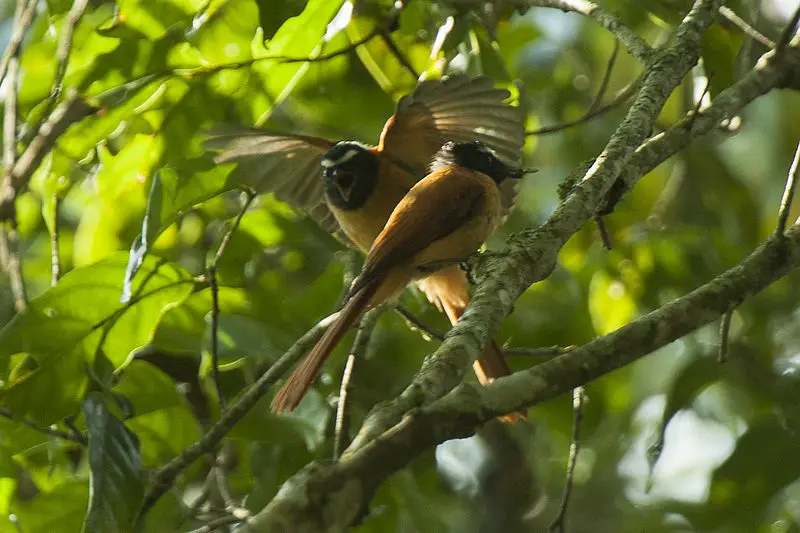
The Black-and-cinnamon fantail bird is a unique species that can be found on the island of Mindanao in the Philippines. This fantail bird belongs to the Rhipiduridae family, and there are two subspecies found on the island.
The bird’s name is derived from the Latin word for black, “niger”, and it is known for its black and cinnamon-colored feathers.
The nominate subspecies is found in central and southern Mindanao, while the R. n. hutchinsoni subspecies inhabits north, western, and eastern Mindanao.
These birds are endemic to the Philippines, which means they are found nowhere else in the world. The Black-and-cinnamon fantail species is a delight to observe in their natural environment, with their unique coloring and distinctive movement patterns.
Scientific classification:
| Kingdom | Animalia |
| Phylum | Chordata |
| Class | Aves |
| Order | Passeriformes |
| Family | Rhipiduridae |
| Genus | Rhipidura |
| Species | R. nigrocinnamomea |
35. Buzzing Flowerpecker
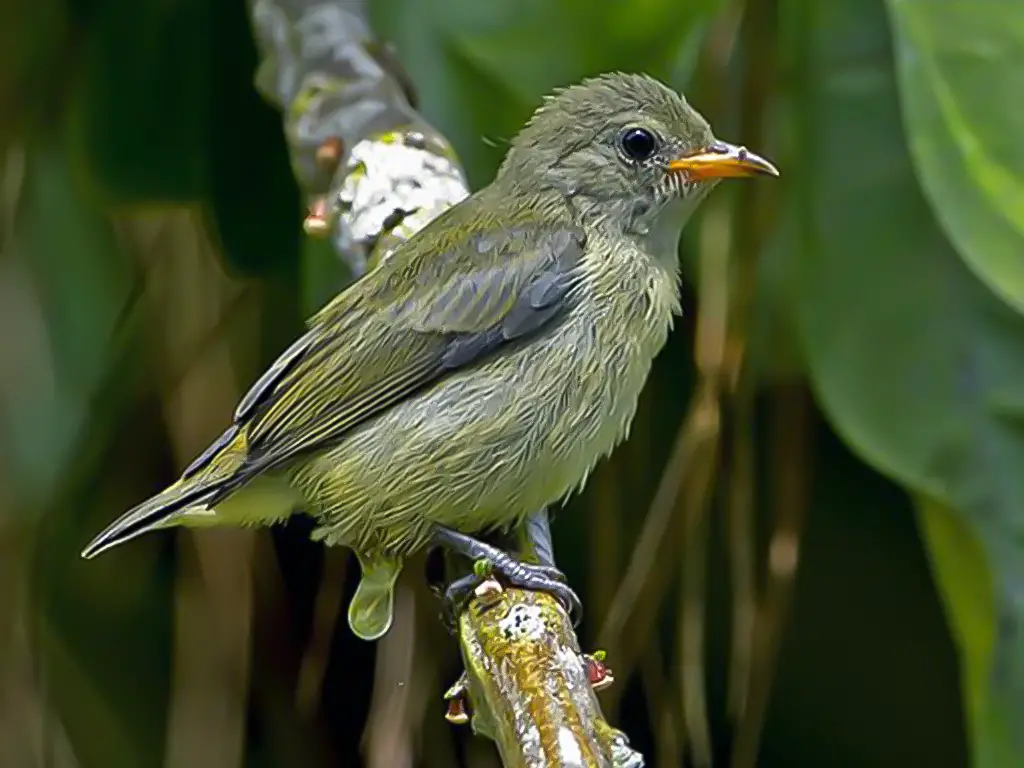
The buzzing flowerpecker, also known as the white-bellied flowerpecker, is a unique bird species that belongs to the Dicaeidae family.
This endemic bird is found solely in the Philippines, where it inhabits subtropical and tropical moist lowland and montane forests.
The buzzing flowerpecker is an attractive bird that features a distinct white belly and a buzzing call, which is where it gets its name.
Ornithologists note that this bird feeds primarily on nectar and pollen, making it a vital pollinator in its forest ecosystem.
Due to its limited range and habitat, the buzzing flowerpecker is considered a vulnerable species that requires conservation efforts to ensure its survival.
Its beauty and ecological importance make this little bird a treasured and special part of the Philippines’ avian diversity.
Scientific classification:
| Kingdom | Animalia |
| Phylum | Chordata |
| Class | Aves |
| Order | Passeriformes |
| Family | Dicaeidae |
| Genus | Dicaeum |
| Species | D. hypoleucum |
36. Mindanao Racket-Tail
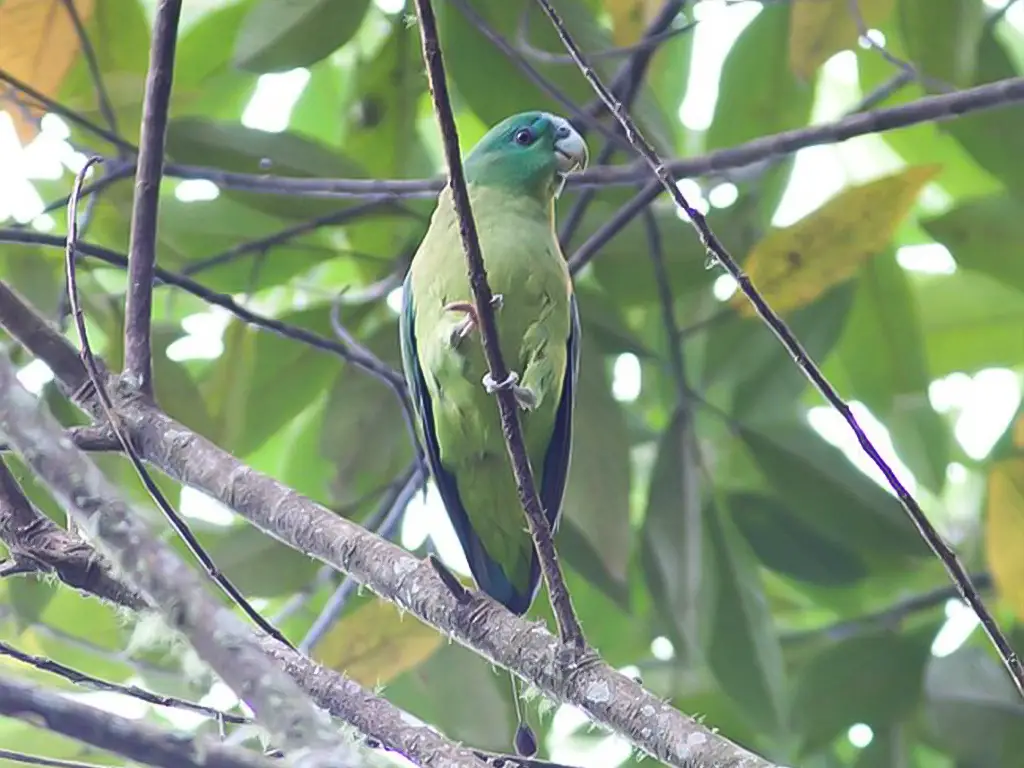
The Mindanao racket-tail bird is a type of parrot that is only found in the Philippines, specifically on the island of Mindanao.
It used to belong to the same species as the Luzon Racket-tail, but with further studies and observations, they were identified as two separate species.
The Mindanao racket-tail can be divided into two subspecies, with the nominate waterstradti located in the southeast and the malindangensis in the western part of the island.
It mostly inhabits the tropical moist montane forests of Mindanao. Unfortunately, this beautiful bird species is becoming rare and endangered due to habitat destruction and hunting.
Scientific classification:
| Kingdom | Animalia |
| Phylum | Chordata |
| Class | Aves |
| Order | Psittaciformes |
| Family | Psittaculidae |
| Genus | Prioniturus |
| Species | P. waterstradti |
37. Whiskered Flowerpecker
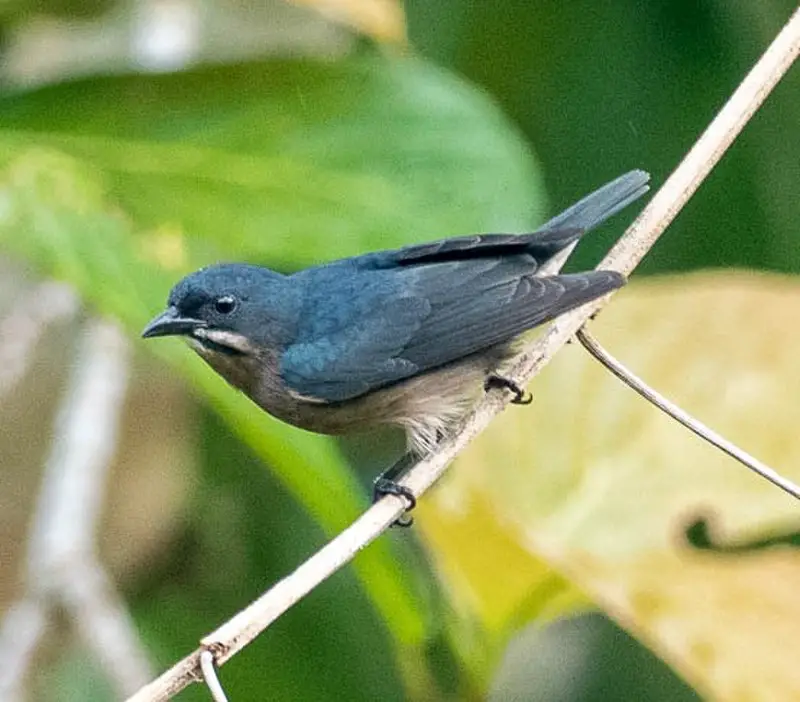
The Whiskered flowerpecker is a small bird that can be found on the island of Mindanao in the Philippines. It lives in subtropical or tropical moist montane forests, and it primarily feeds on mistletoe.
The bird has glossy black feathers on its back, while its underparts are pale gray. One noteworthy feature of this bird is the pronounced white whiskers on its face, which give it its name.
Sadly, the Whiskered flowerpecker is becoming increasingly rare due to habitat loss, and it is considered an endangered species.
As a result, conservation efforts are underway to protect the bird and restore its habitat.
Scientific classification:
| Kingdom | Animalia |
| Phylum | Chordata |
| Class | Aves |
| Order | Passeriformes |
| Family | Dicaeidae |
| Genus | Dicaeum |
| Species | D. proprium |
38. Short-Crested Monarch
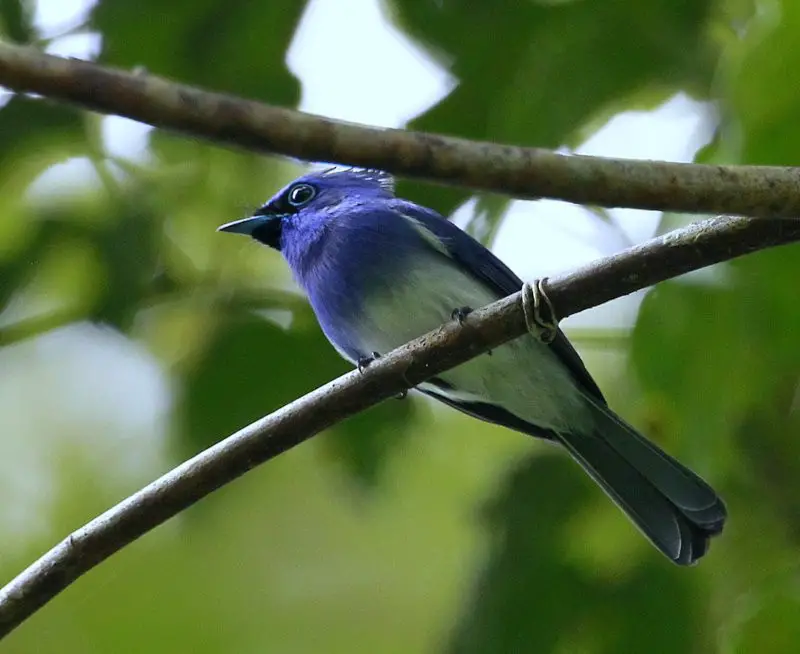
The Short-crested monarch is a small bird that is native to the Philippines. Its habitat consists of tropical moist lowland forests, but unfortunately, it is at risk due to habitat loss.
The male Short-crested monarch has deep-blue upperparts, head, and chest, and a white belly. It can be distinguished from the Black-naped Monarch by certain characteristics, though these are not specified in the limited information given.
It is a part of the Monarchidae family and is known for its distinctive short crest. This beautiful bird has a vulnerable status, and conservation efforts are necessary to protect its existence.
Scientific classification:
| Kingdom | Animalia |
| Phylum | Chordata |
| Class | Aves |
| Order | Passeriformes |
| Family | Monarchidae |
| Genus | Hypothymis |
| Species | H. helenae |
39. White-Cheeked Bullfinch
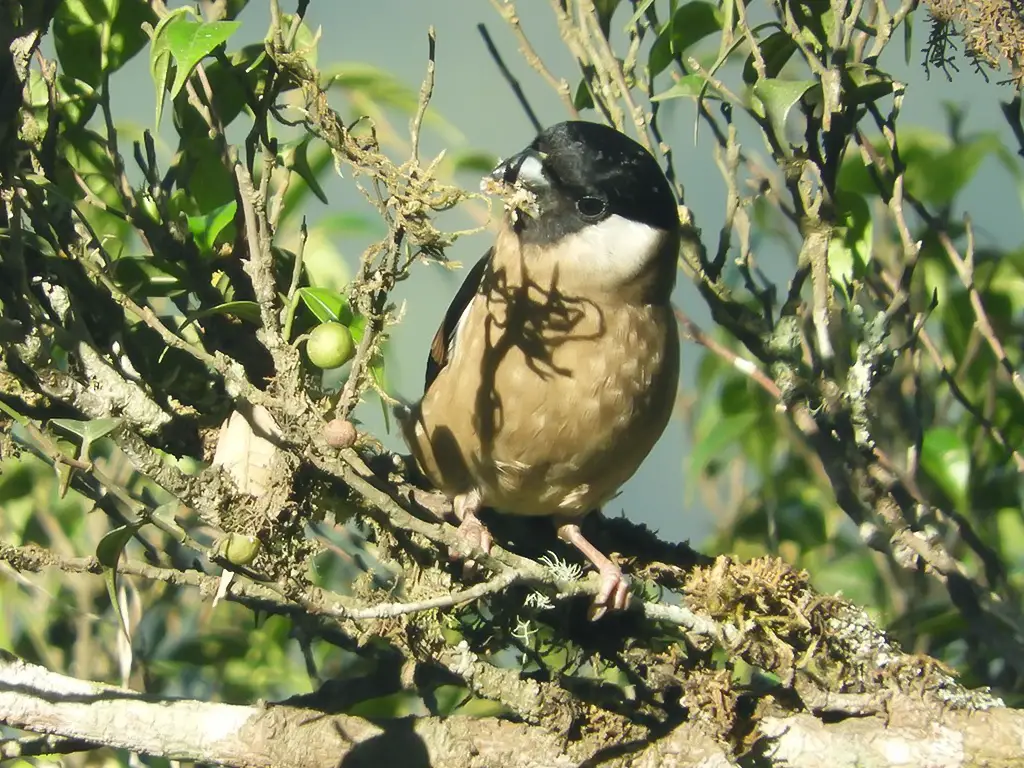
The White-cheeked bullfinch is a type of finch found in the mountainous regions of the Philippines, particularly on the Luzon and Mindanao islands. They prefer to reside in subtropical or tropical humid forests.
This bird species is not considered threatened with a conservation status of “least concern.”
Scientific classification:
| Kingdom | Animalia |
| Phylum | Chordata |
| Class | Aves |
| Order | Passeriformes |
| Family | Fringillidae |
| Subfamily | Carduelinae |
| Genus | Pyrrhula |
| Species | P. leucogenis |
40. Yellow-Crowned Flowerpecker
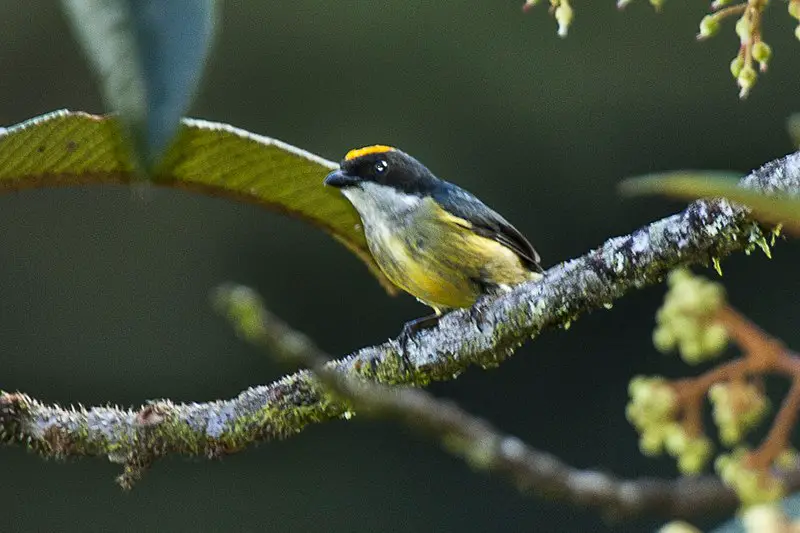
The Yellow-crowned flowerpecker is a rare bird species that is endemic to Luzon Island in the Philippines. Its small size and striking yellow crown make it a fascinating sight to behold.
The bird’s natural habitat is tropical moist montane forest, but habitat loss has led to a decline in its population. The flame-crowned flowerpecker, previously believed to be the same species, is now considered a separate species endemic to Mindanao.
Despite its small size, the Yellow-crowned flowerpecker is an important inhabitant of the forest ecosystem, playing a crucial role in pollination and seed dispersal. It is a true gem of the Philippine avian fauna.
Scientific classification:
| Kingdom | Animalia |
| Phylum | Chordata |
| Class | Aves |
| Order | Passeriformes |
| Family | Dicaeidae |
| Genus | Dicaeum |
| Species | D. anthonyi |
41. White-Fronted Tit
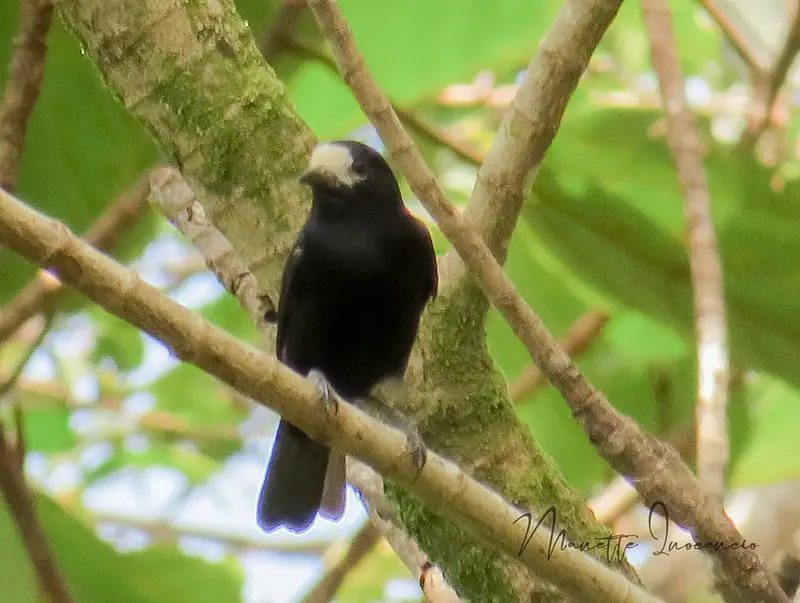
The White-fronted tit is a species of bird that belongs to the Paridae family, endemic to the Philippines. This tiny bird can be found in Luzon and Mindanao islands.
Its natural habitat consists of tropical moist lowland forests; however, due to habitat loss, it is now facing a threat. The bird is entirely dark in color with a noticeable white mark.
They are uncommon and usually spotted in the canopy and edge of lowland and foothill forests. The White-fronted tit is a treasured species of bird that demands protection and conservation efforts to ensure its survival.
Scientific classification:
| Kingdom | Animalia |
| Phylum | Chordata |
| Class | Aves |
| Order | Passeriformes |
| Family | Paridae |
| Genus | Sittiparus |
| Species | S. semilarvatus |
42. Lina’s Sunbird
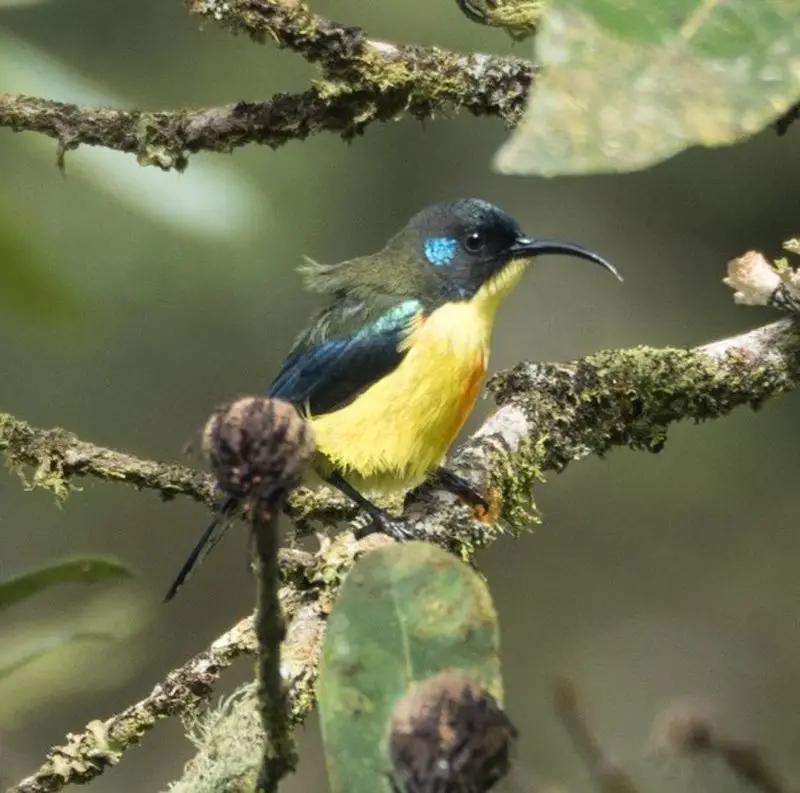
Lina’s sunbird, also known as Aethopyga linaraborae, is a stunning bird species found in the Philippines. This mountain-dwelling bird is endemic to the island of Mindanao, where it thrives in tropical moist montane forests.
The males of the species are particularly distinctive, featuring bright iridescent blue feathers and a striking orange spot on their yellow breast. Feminine birds are slightly more understated in appearance, boasting a green and yellow color palette.
The bird was named after Dioscoro S. Rabor’s wife, Lina. Overall, Lina’s sunbird is a highly visible and attractive species, thanks to its unique coloring and natural habitat.
It is widely considered to be one of the most beautiful and striking sunbirds in the Philippines.
Scientific classification:
| Kingdom | Animalia |
| Phylum | Chordata |
| Class | Aves |
| Order | Passeriformes |
| Family | Nectariniidae |
| Genus | Aethopyga |
| Species | A. linaraborae |
43. Philippine Bulbul
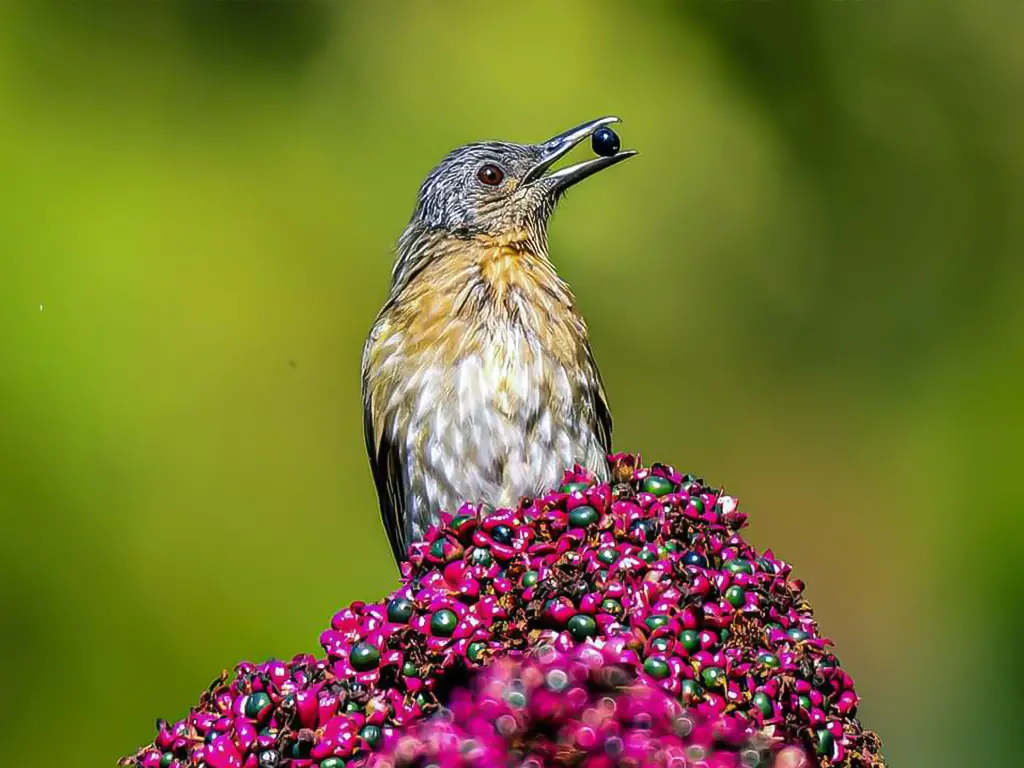
The Philippine Bulbul bird is a type of songbird found only in the Philippines. It belongs to the bulbul family and prefers to live in subtropical or tropical forests.
It can be found on Mount Kitanglad on Mindanao and is most commonly found in primary forests at elevations between 500 and 2,250 meters.
This bird is abundant in the wild and has distinct features such as its yellow belly and black head.
The Philippine Bulbul bird is an important part of the Philippines’ wildlife and is appreciated by bird watchers around the world. Its unique habitat and characteristics make it a unique and fascinating species.
Scientific classification:
| Kingdom | Animalia |
| Phylum | Chordata |
| Class | Aves |
| Order | Passeriformes |
| Family | Pycnonotidae |
| Genus | Hypsipetes |
| Species | H. philippinus |
44. Metallic-Winged Sunbird
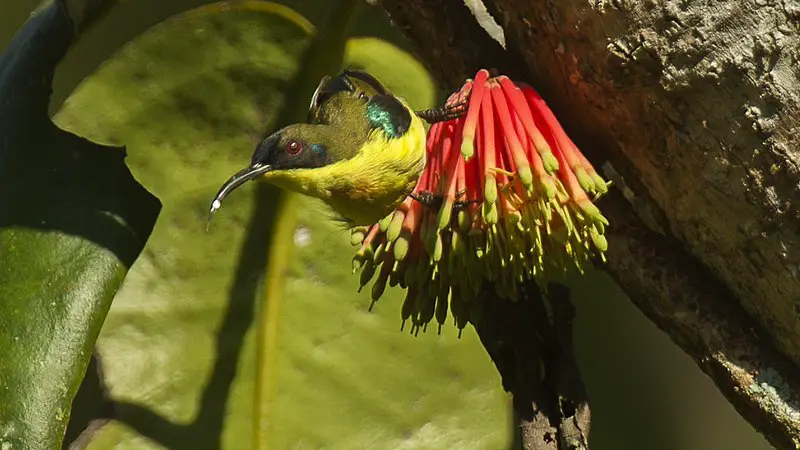
The Metallic-winged sunbird is a striking bird that can only be found in the Philippines. This bird belongs to the Nectariniidae family and is known for its beautiful metallic wings.
Its habitat consists of moist forests that are either lowland or montane. The bird is a popular sight for birdwatchers who visit the country.
The sunbird has a unique diet that mainly consists of nectar, which it extracts from flowers using its long, curved beak.
It is known to play a crucial role in pollination, making it an essential part of the ecosystem. The Metallic-winged sunbird is also a popular subject for photographers and artists who appreciate its striking beauty.
Its presence in its natural habitat is a testament to the biodiversity of the Philippines and the importance of conservation efforts.
Scientific classification:
| Kingdom | Animalia |
| Phylum | Chordata |
| Class | Aves |
| Order | Passeriformes |
| Family | Nectariniidae |
| Genus | Aethopyga |
| Species | A. pulcherrima |
45. Naked-Faced Spiderhunter
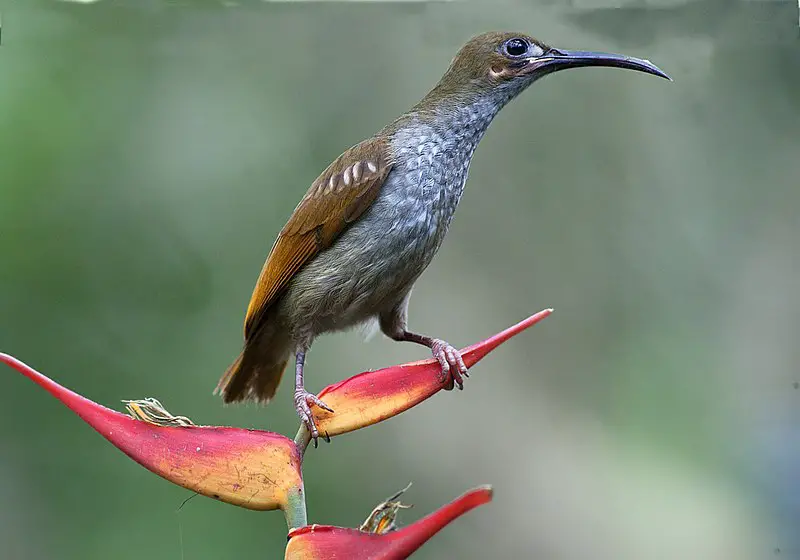
The Naked-faced spiderhunter is a bird species found only in the Philippines. It belongs to the Nectariniidae family. The bird has a distinct feature of a bare face, and its name suggests the same.
Its natural habitat includes subtropical or tropical moist lowland forests. The bird is known for its unique feeding habits as it primarily feeds on nectar and insects. It has a slender body and a long curved beak, which assists it in reaching the nectar in flowers.
Typically, the male bird has a shiny green-scaled body, whereas the females have a dull brownish-green body. They are known to be solitary birds, and their populations have been declining due to habitat loss and deforestation.
Therefore, efforts are being made to conserve this unique bird species to maintain ecological balance.
Scientific classification:
| Kingdom | Animalia |
| Phylum | Chordata |
| Class | Aves |
| Order | Passeriformes |
| Family | Nectariniidae |
| Genus | Arachnothera |
| Species | A. clarae |
46. Mindanao Blue Fantail
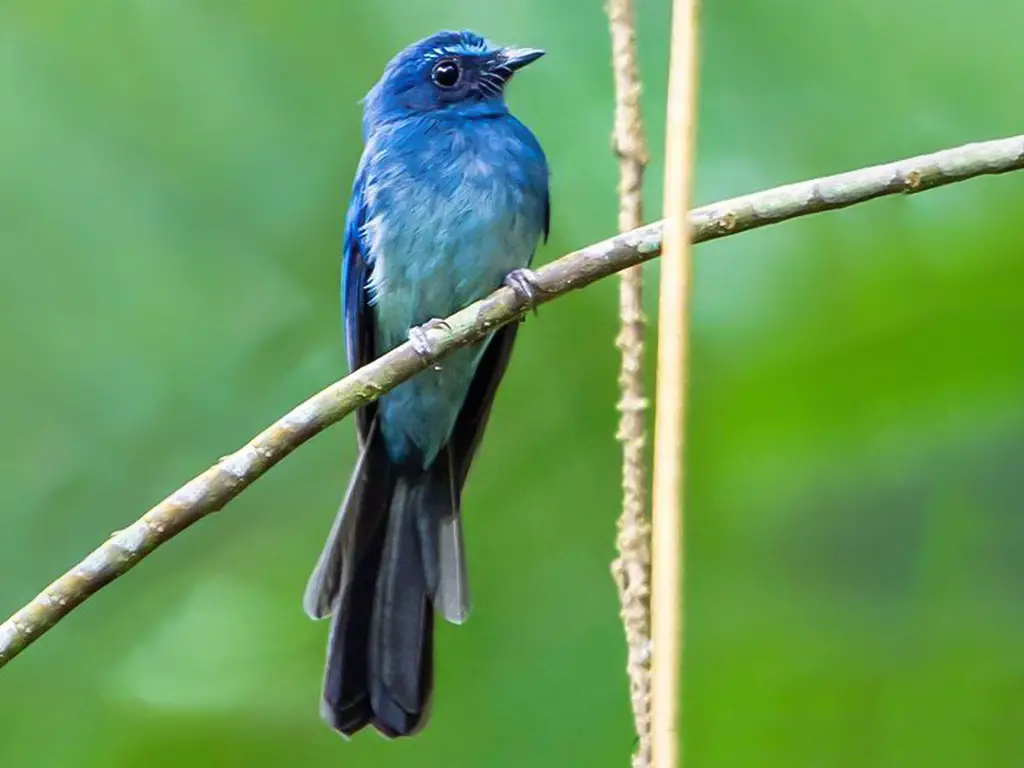
The Mindanao blue fantail is a bird species found only in the Philippines. They belong to the family Rhipiduridae, which consists of 47 species, and are commonly found in subtropical or tropical moist lowland forests.
This bird was previously known as the Visayan blue fantail but it has been reclassified as a separate species. The Mindanao blue fantail has a distinct, vivid blue color on its feathers.
Due to their native habitat, they are becoming increasingly vulnerable to deforestation and habitat loss.
Conservation efforts are underway to protect these birds and ensure their survival. They are known for their elegant and delicate movements, which are a delight to watch.
True bird enthusiasts can spot them in the Philippines and admire their beauty in their natural surroundings.
Scientific classification:
| Kingdom | Animalia |
| Phylum | Chordata |
| Class | Aves |
| Order | Passeriformes |
| Family | Rhipiduridae |
| Genus | Rhipidura |
| Species | R. superciliaris |
47. Yellow-Bellied Whistler
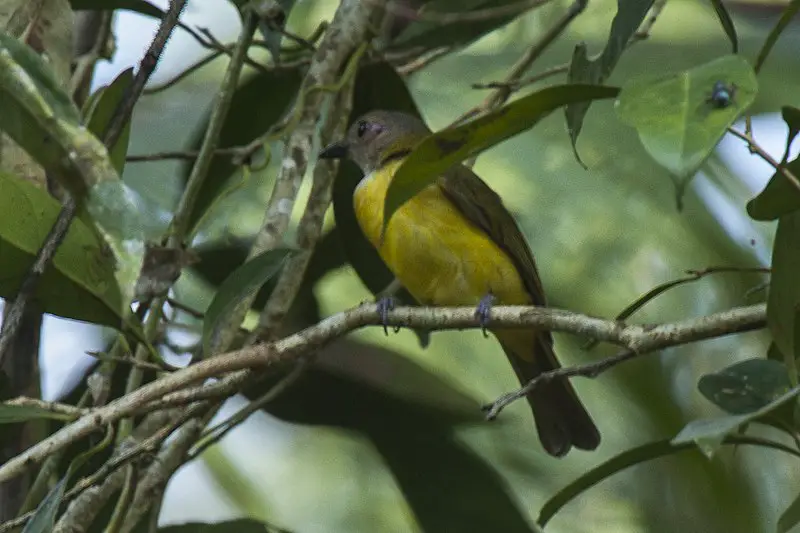
The Yellow-bellied whistler is a bird native to the Philippines. It belongs to the family Pachycephalidae and is also known as the Philippine whistler.
Its preferred habitat is in subtropical or tropical moist lowland forest and subtropical or tropical moist montane forest.
With seven recognized subspecies, the Yellow-bellied whistler is a diverse bird with slight variations in appearance. Its bright yellow belly is a distinctive feature of this species.
The bird is known for its melodious whistling song, hence its name. This bird can be difficult to spot as it generally keeps to the tree branches.
Despite not being considered endangered, deforestation and habitat loss threaten the survival of the Yellow-bellied whistler and its populations are declining.
Scientific classification:
| Kingdom | Animalia |
| Phylum | Chordata |
| Class | Aves |
| Order | Passeriformes |
| Family | Pachycephalidae |
| Genus | Pachycephala |
| Species | P. philippinensis |
48. Brown Tit-Babbler
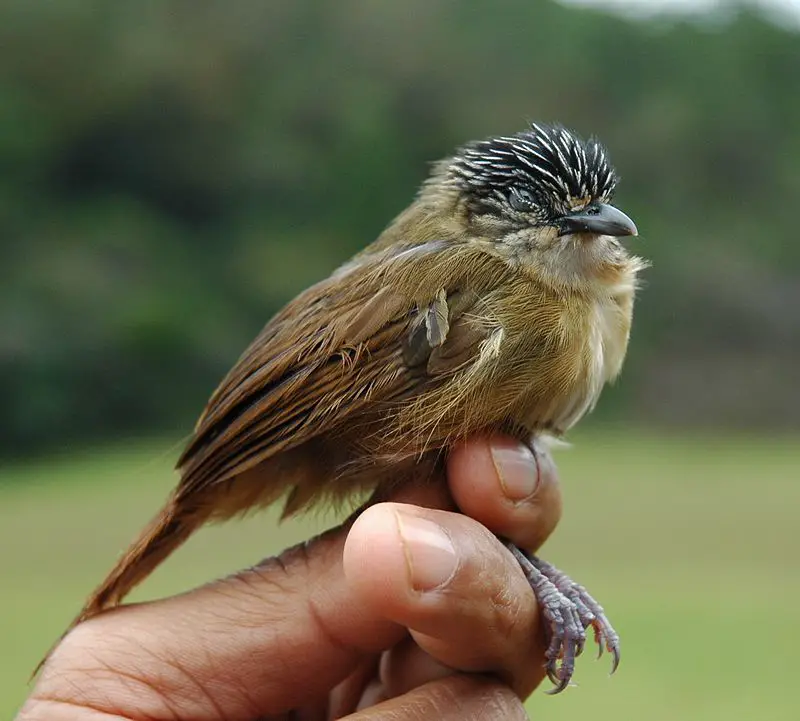
The Brown tit-babbler, a bird in the Timaliidae family, can only be found in the Philippines. This species enjoys living in either subtropical or tropical moist lowland forests or subtropical or tropical moist montane forests.
The Brown tit-babbler is known for its distinctive striped head. As an endemic species, populations of this bird face threats such as habitat loss and fragmentation due to deforestation, logging, and agriculture.
With limited range and population size, conservation efforts are necessary to protect this unique and vulnerable bird species.
Overall, the Brown tit-babbler is a fascinating bird that plays an important role in the Philippines’ biodiversity.
Scientific classification:
| Kingdom | Animalia |
| Phylum | Chordata |
| Class | Aves |
| Order | Passeriformes |
| Family | Timaliidae |
| Genus | Macronus |
| Species | M. striaticeps |
49. Mindanao Lorikeet
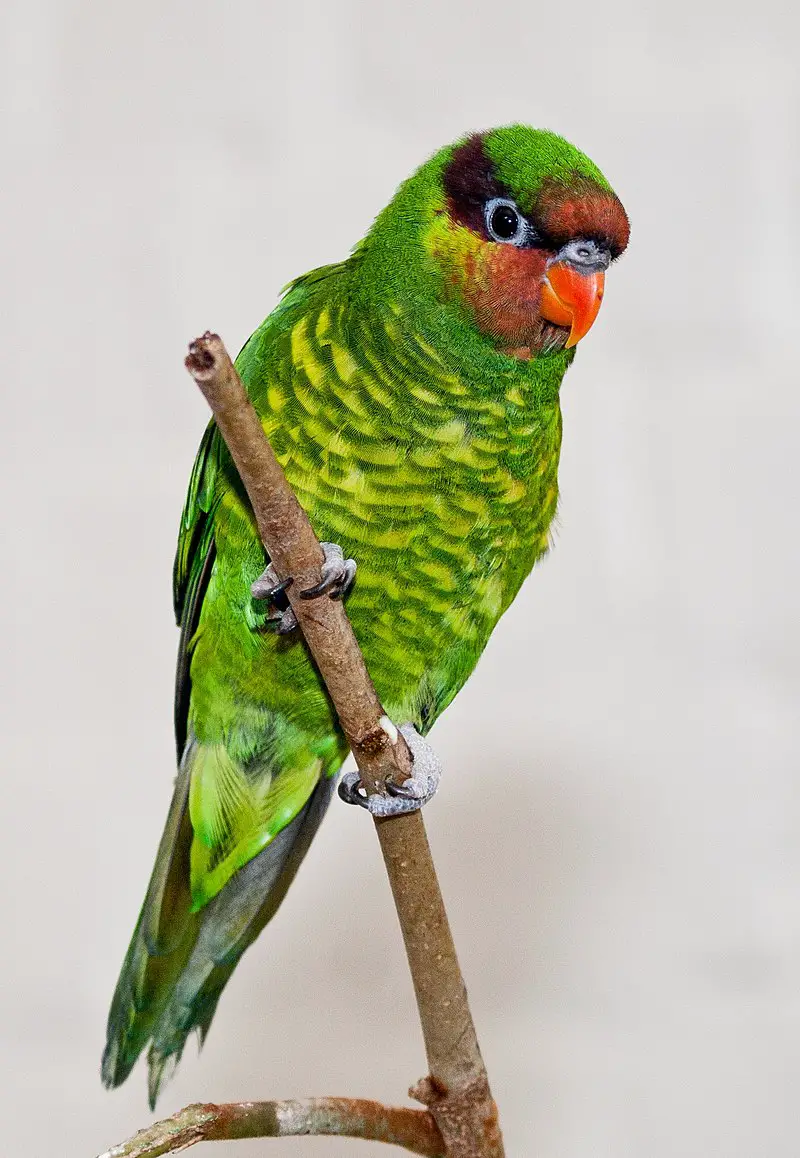
The Mindanao lorikeet, also known as the Mount Apo lorikeet, is a parrot species belonging to the family Psittaculidae. Endemic to Mindanao in the Philippines, there are two subspecies that are almost identical.
The natural habitat of this species is the subtropical or tropical moist montane forests. Sadly, this bird is under threat due to habitat loss and is often captured for the illegal wildlife trade.
The population of the Mindanao lorikeet has been estimated to be very low by the International Union for Conservation of Nature (IUCN).
The beautiful and colorful plumage of this species makes it a prized possession for pet owners which has led to further decline in its population. Conservation efforts are crucial to ensure the survival of this magnificent bird species.
Scientific classification:
| Kingdom | Animalia |
| Phylum | Chordata |
| Class | Aves |
| Order | Psittaciformes |
| Family | Psittaculidae |
| Genus | Saudareos |
| Species | S. johnstoniae |
50. Rufous-Fronted Tailorbird
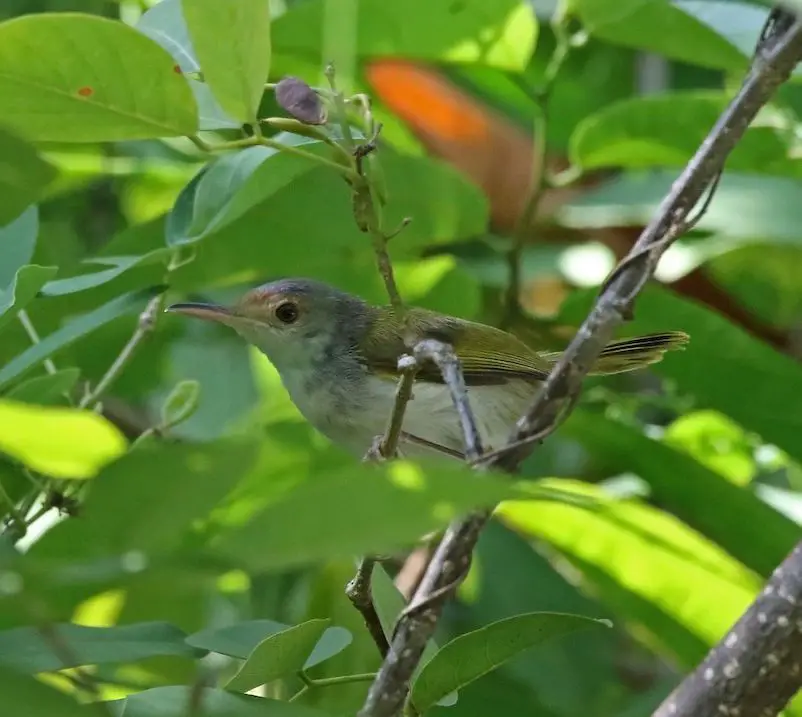
The Rufous-fronted tailorbird is a bird that belongs to the family Cisticolidae. It is commonly found in the southern and eastern parts of the Philippines.
This bird species prefers to live in moist lowland forests or mangrove forests that are subtropical or tropical. It was once placed in the Old World warbler assemblage, but was later classified as part of the Cisticolidae family.
This bird has a distinct appearance with its rufous-colored head and front, hence its name. It is a small bird that is known for its singing abilities, with a loud and melodious call that can often be heard in the forest.
The Rufous-fronted tailorbird’s natural habitats are subtropical or tropical regions with dense foliage, where it feeds on insects and spiders.
Scientific classification:
| Kingdom | Animalia |
| Phylum | Chordata |
| Class | Aves |
| Order | Passeriformes |
| Family | Cisticolidae |
| Genus | Orthotomus |
| Species | O. frontalis |
51. Yellow-Wattled Bulbul
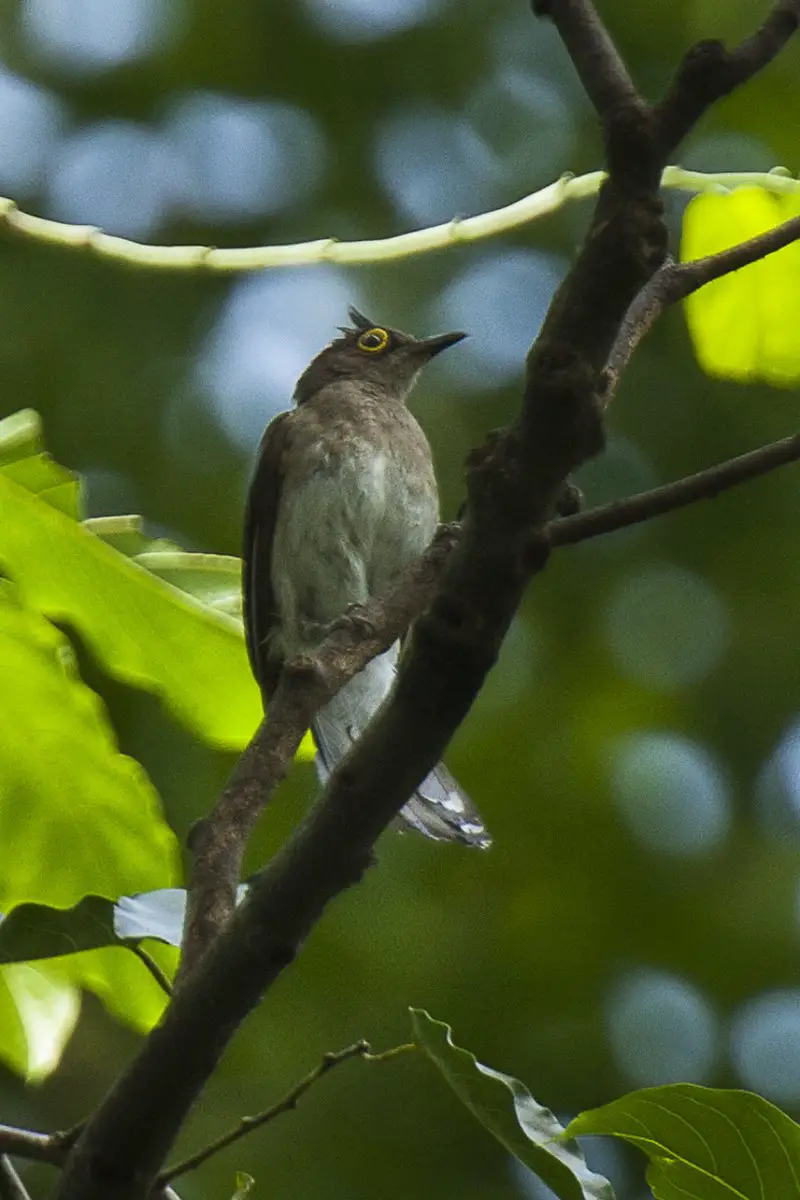
The Yellow-wattled bulbul is a bird found in the Philippines. It belongs to the bulbul family and is known for its distinctive yellow wattles. It prefers to live in subtropical or tropical moist lowland forests.
This bird was first described by Tommaso Salvadori in 1870. Interestingly, it is sometimes just referred to as the wattled bulbul, along with the blue-wattled bulbul.
Overall, this bird is a beautiful and unique species that is cherished by birdwatchers and nature enthusiasts.
Scientific classification:
| Kingdom | Animalia |
| Phylum | Chordata |
| Class | Aves |
| Order | Passeriformes |
| Family | Pycnonotidae |
| Genus | Poliolophus Sharpe, 1877 |
| Species | P. urostictus |